Answered step by step
Verified Expert Solution
Question
1 Approved Answer
Research Target corporation. Access the corporation's annual report for the most recent year available and review the financial statements and related notes. Using APA format
- Research Target corporation. Access the corporation's annual report for the most recent year available and review the financial statements and related notes. Using APA format (no abstract necessary), write an 800- to 1,200-word essay in Microsoft Word answering the questions below.
- The essay must include an introduction, body, and conclusion, and address all parts of the question. Please note that originality is the expectation - your own words with reference support. Overuse of direct quotes and copy and paste are not acceptable and may be considered as plagiarism. (See your Syllabus for details.)
- Make sure to cite any references you use.?At a minimum, you must cite the annual report, the textbook, and 1 (one) peer reviewed article.
- All references must be cited in APA format as noted in the Lesson 0 instruction. Please refer to the grading matrix as shown in the Syllabus for essay assignments.
- Briefly describe the company(corporation), product, and the industry within which it operates. When is the fiscal year end for this company? What are the company's total assets, liabilities, and equity, Income (loss) for the most recent year?
- Identify all three inventory methods including their advantages and disadvantages. Identify the inventory method used by your selected corporation. How does this corporation value its inventories? Why do you think the corporation selected this inventory method? Explain your answer.
- Use the cost of goods sold formula to compute net purchases, which are not reported in the corporation's financial statements. Include your calculations.
- Analyze your selected corporation's strengths and weaknesses. Elaborate on why the strengths you identified are strengths. If you included any weaknesses, what would you suggest to your selected corporation to improve the weaknesses? Be specific. Support your assertion with research and cite your sources.
- Determine your selected corporation's inventory turnover and days' sales in inventory for the year ended. (Round each ratio to one decimal place.)
- Find your selected corporation's biggest competitor and access their annual report for the most recent year available. How do your selected corporation's inventory turnover and days' sales in inventory compare with their competitor's most recent annual report?
- Conclude the essay by answering the following questions: Do you consider this an optimal analysis for determining whether to invest in your selected corporation? Why or why not? The conclusion should be built on the information you provided in the body of the essay. Do not introduce new ideas in the conclusion.
Essay Questions
Report
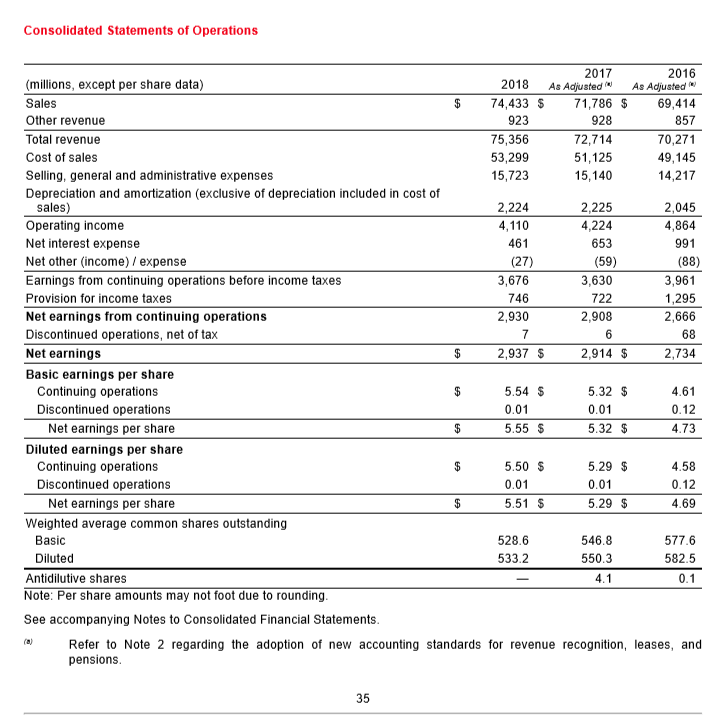
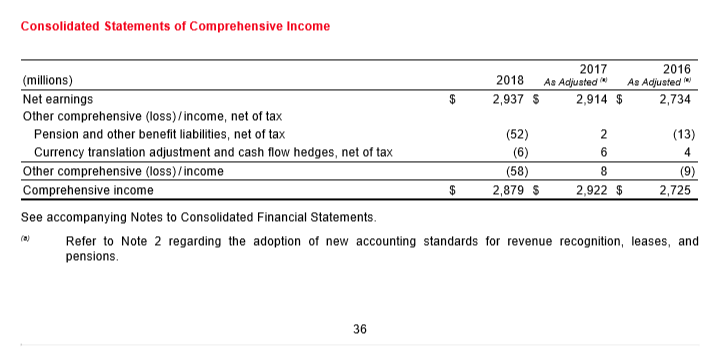
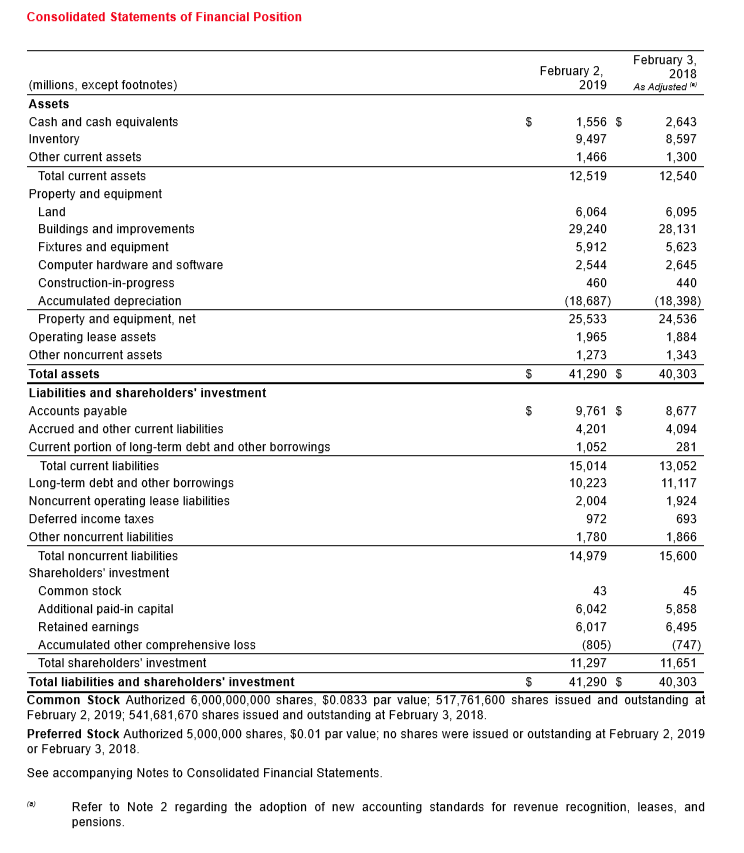
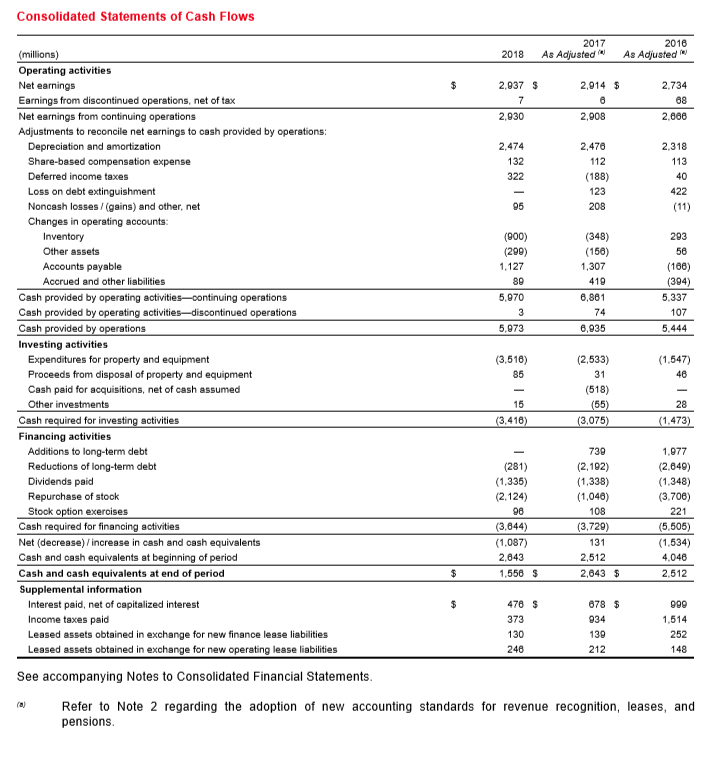
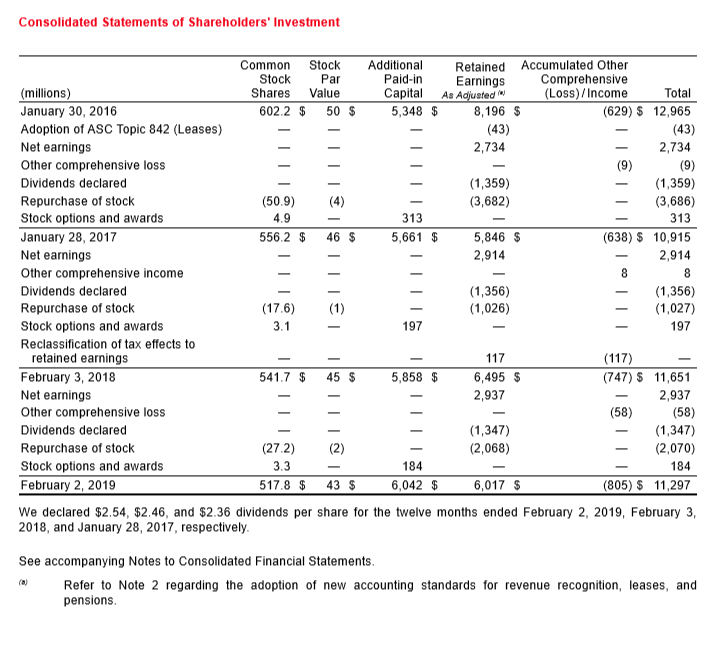
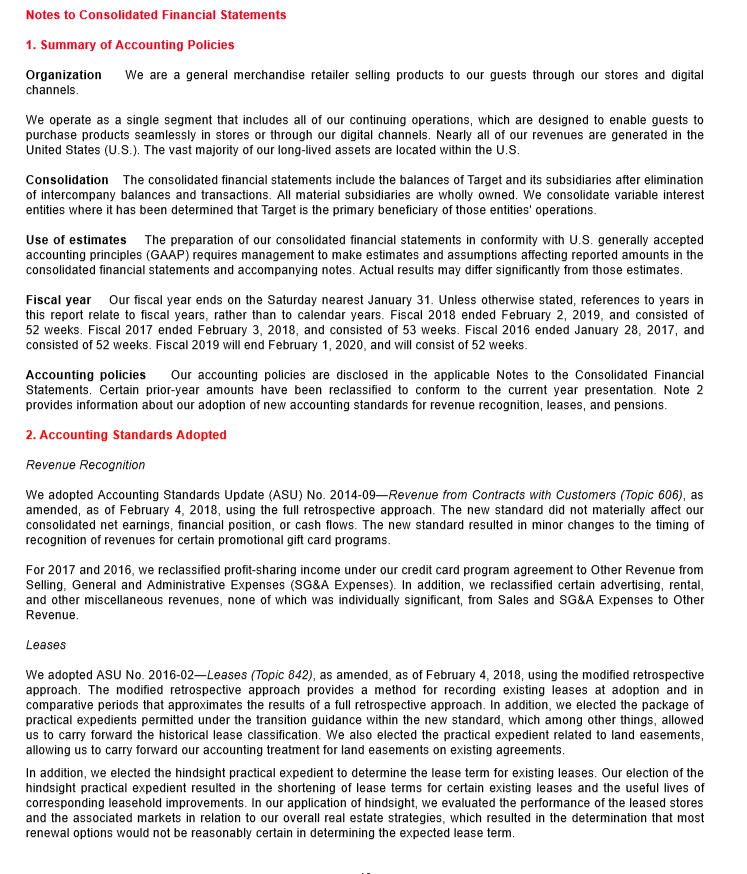
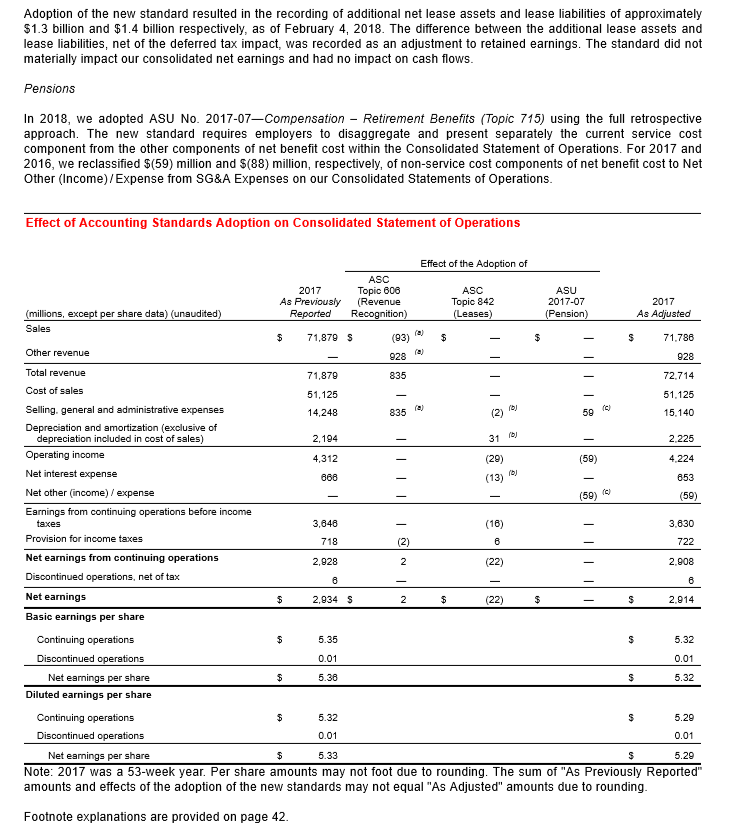
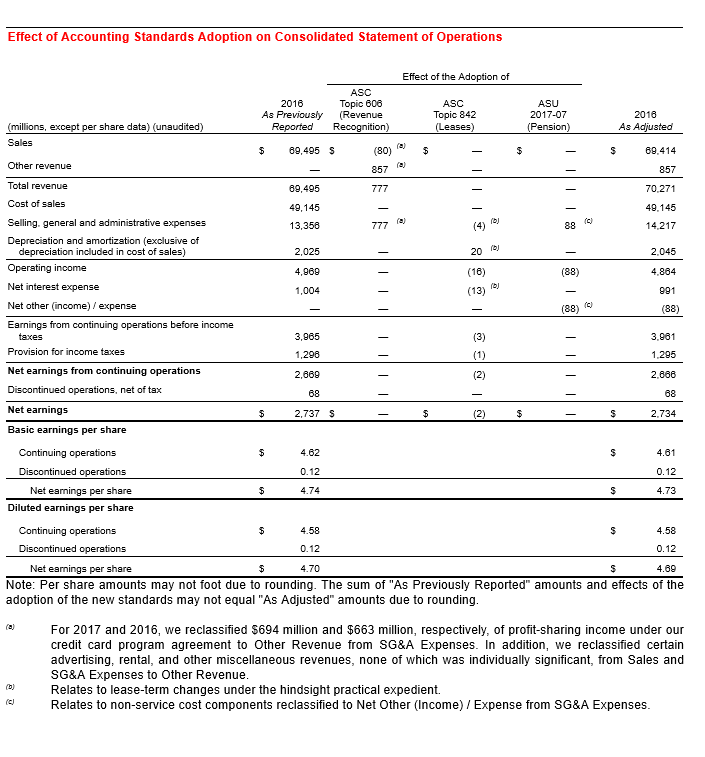
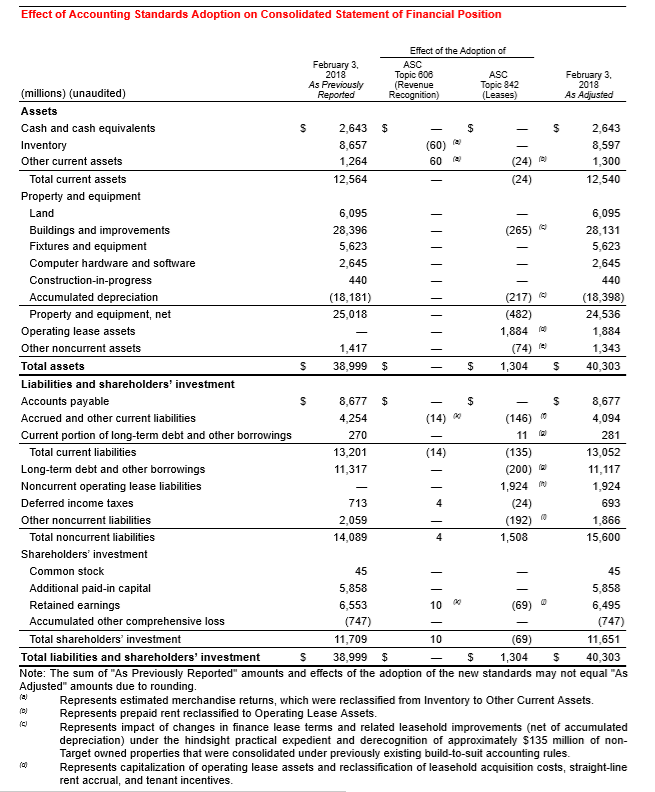
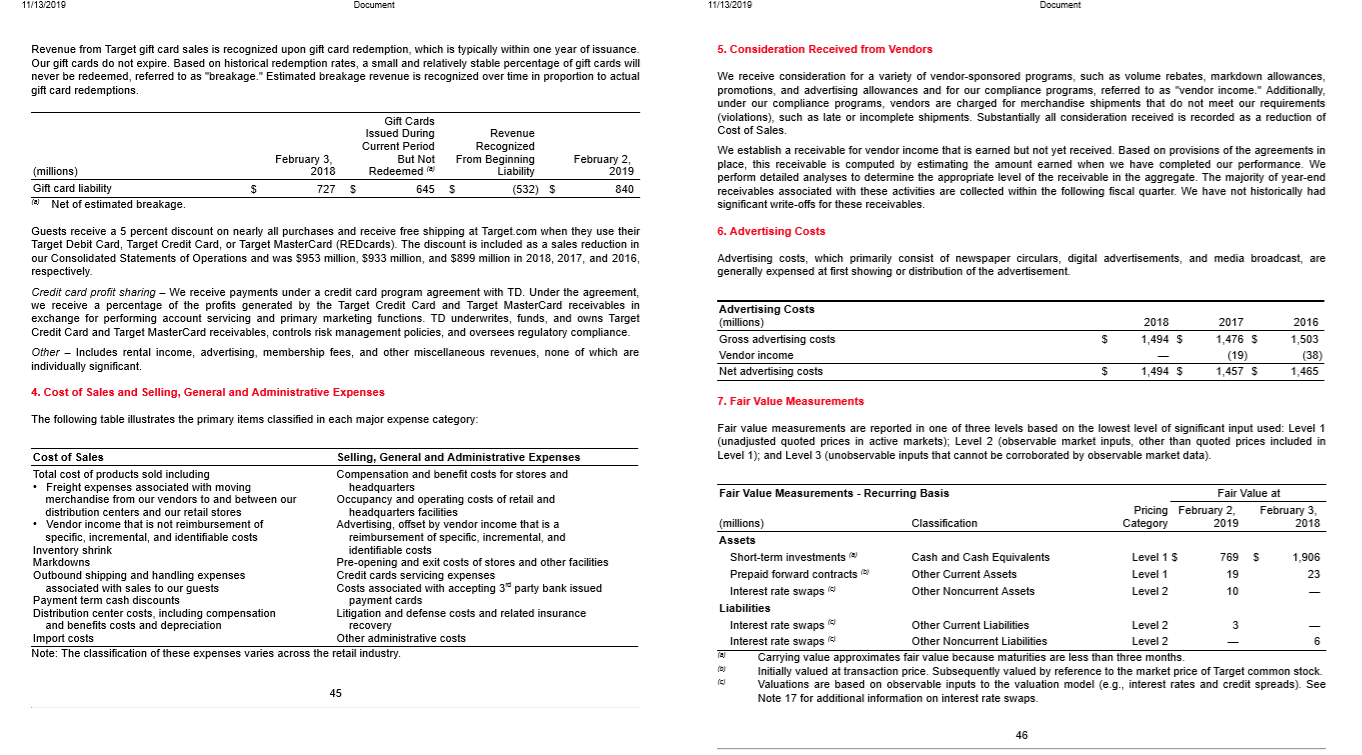
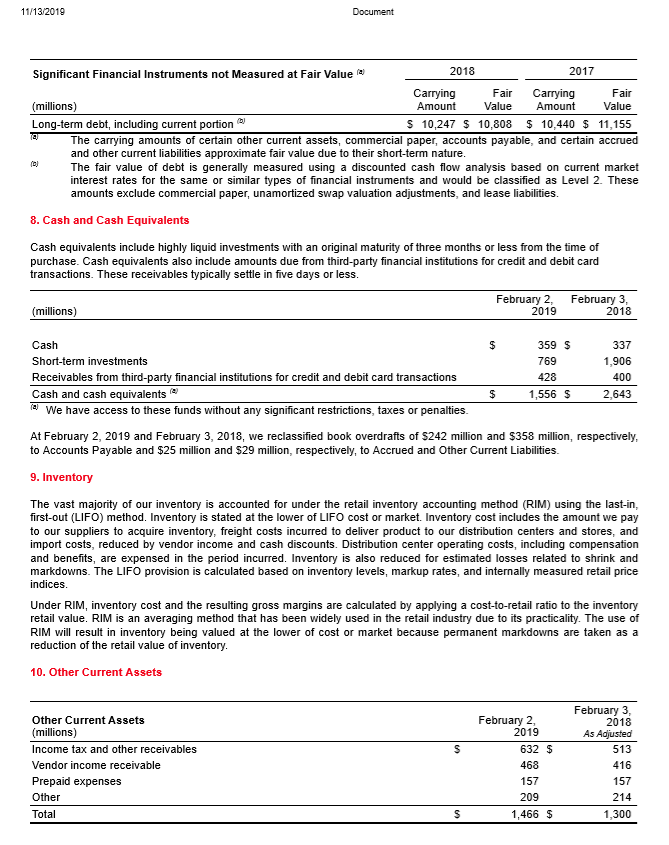
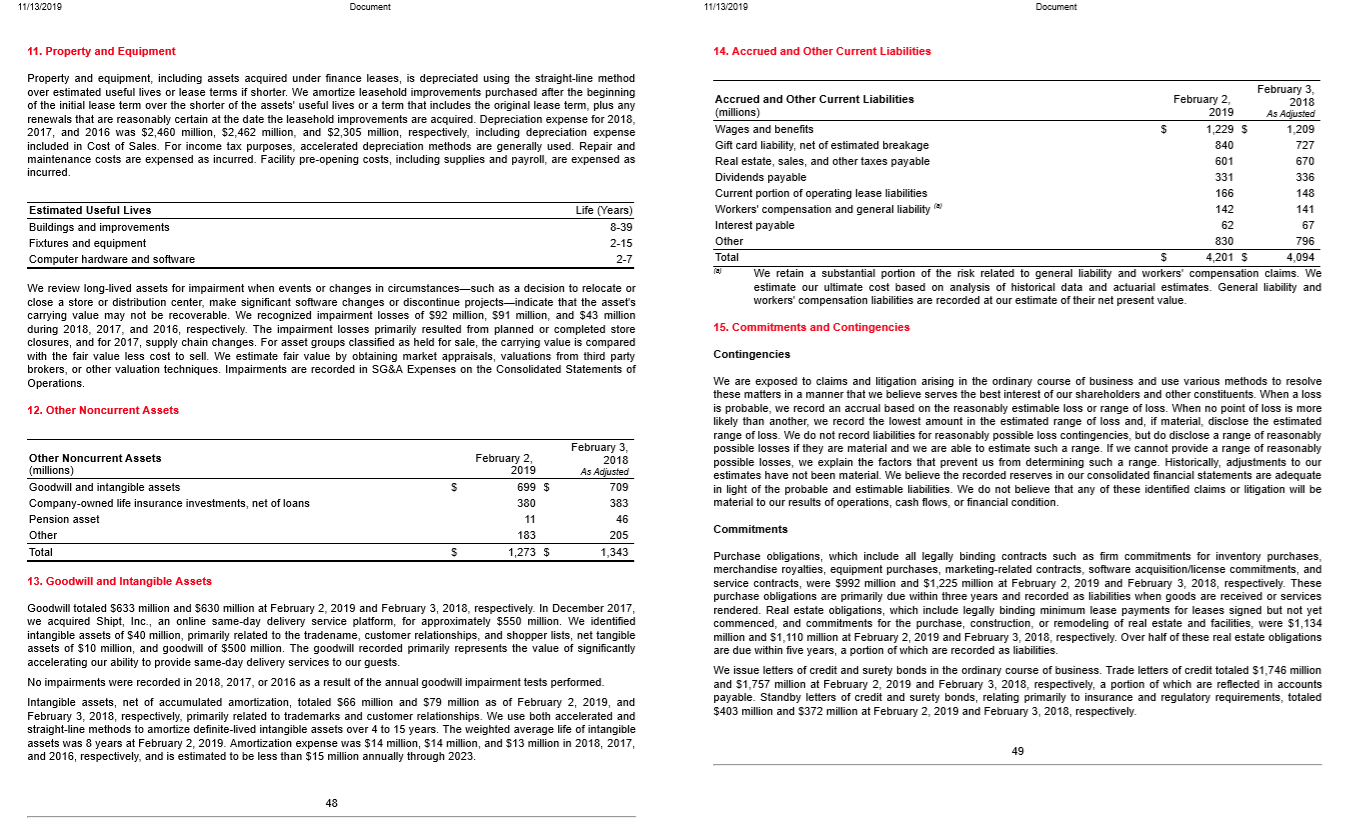
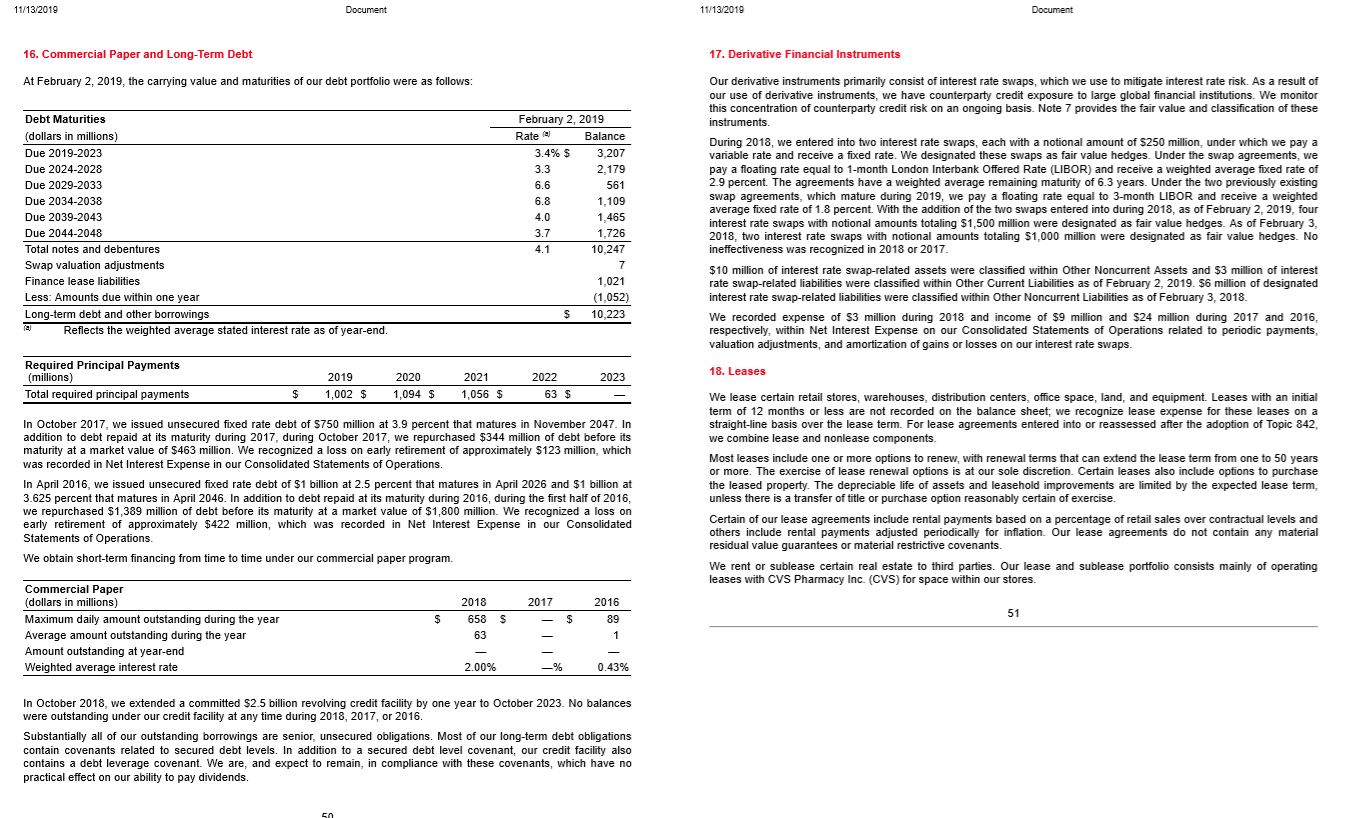
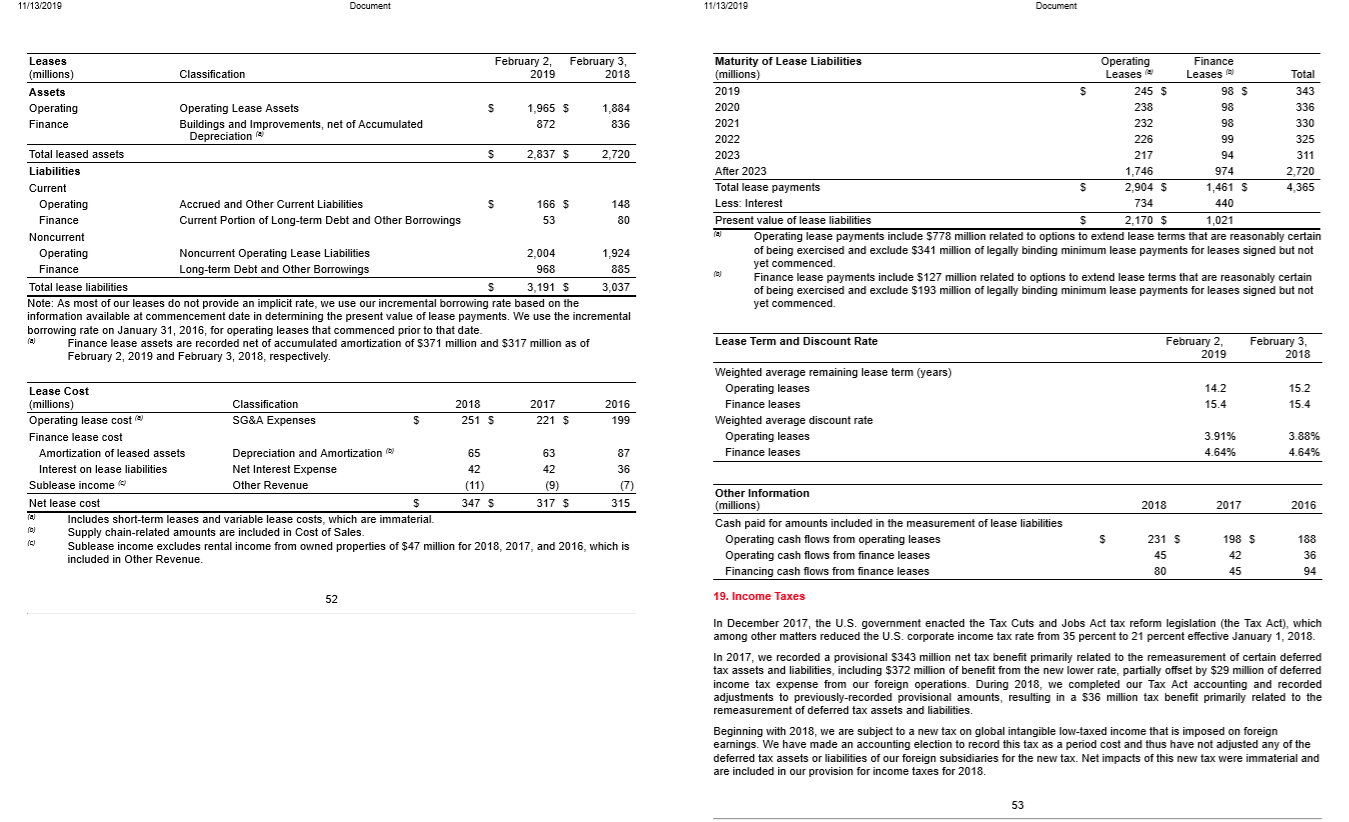
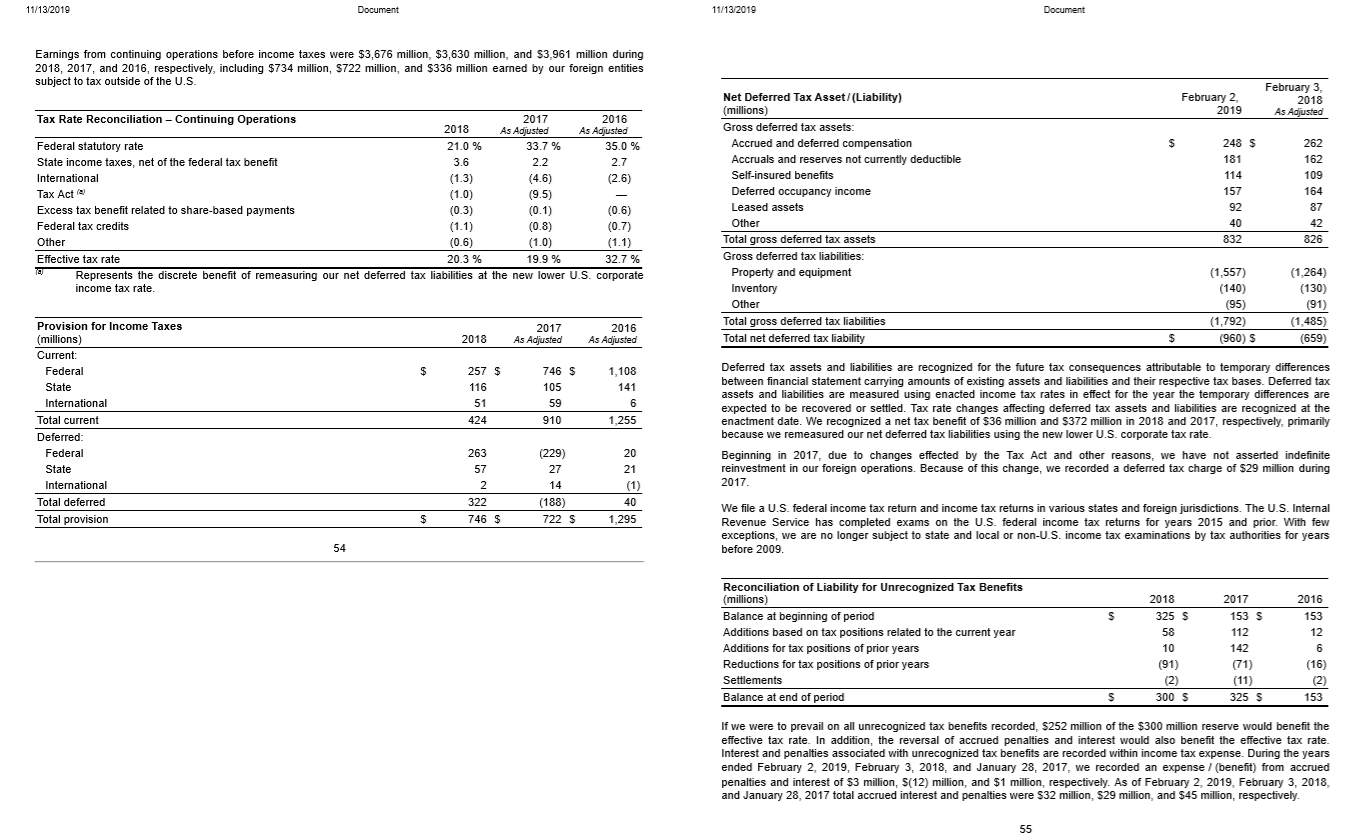
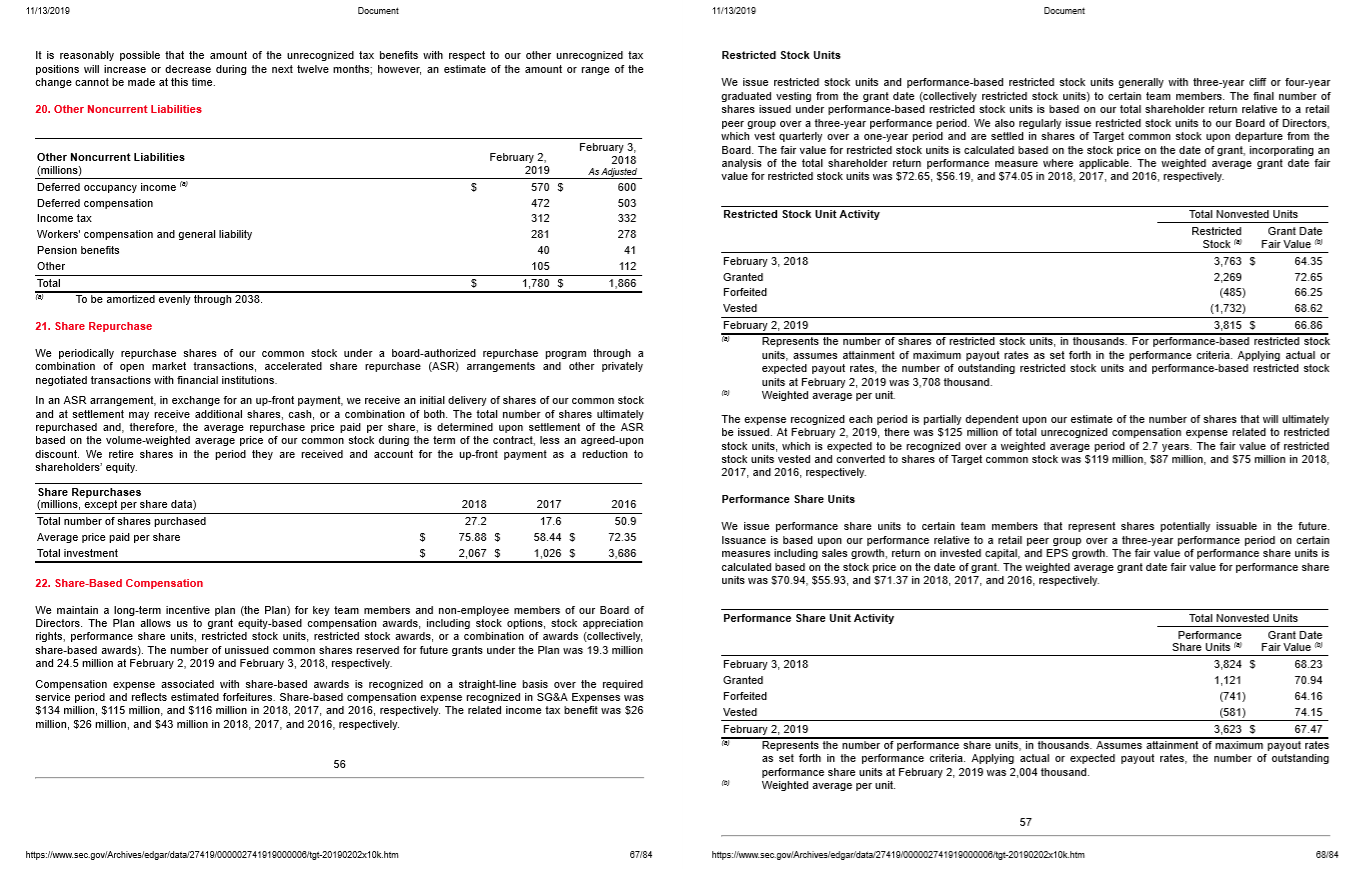
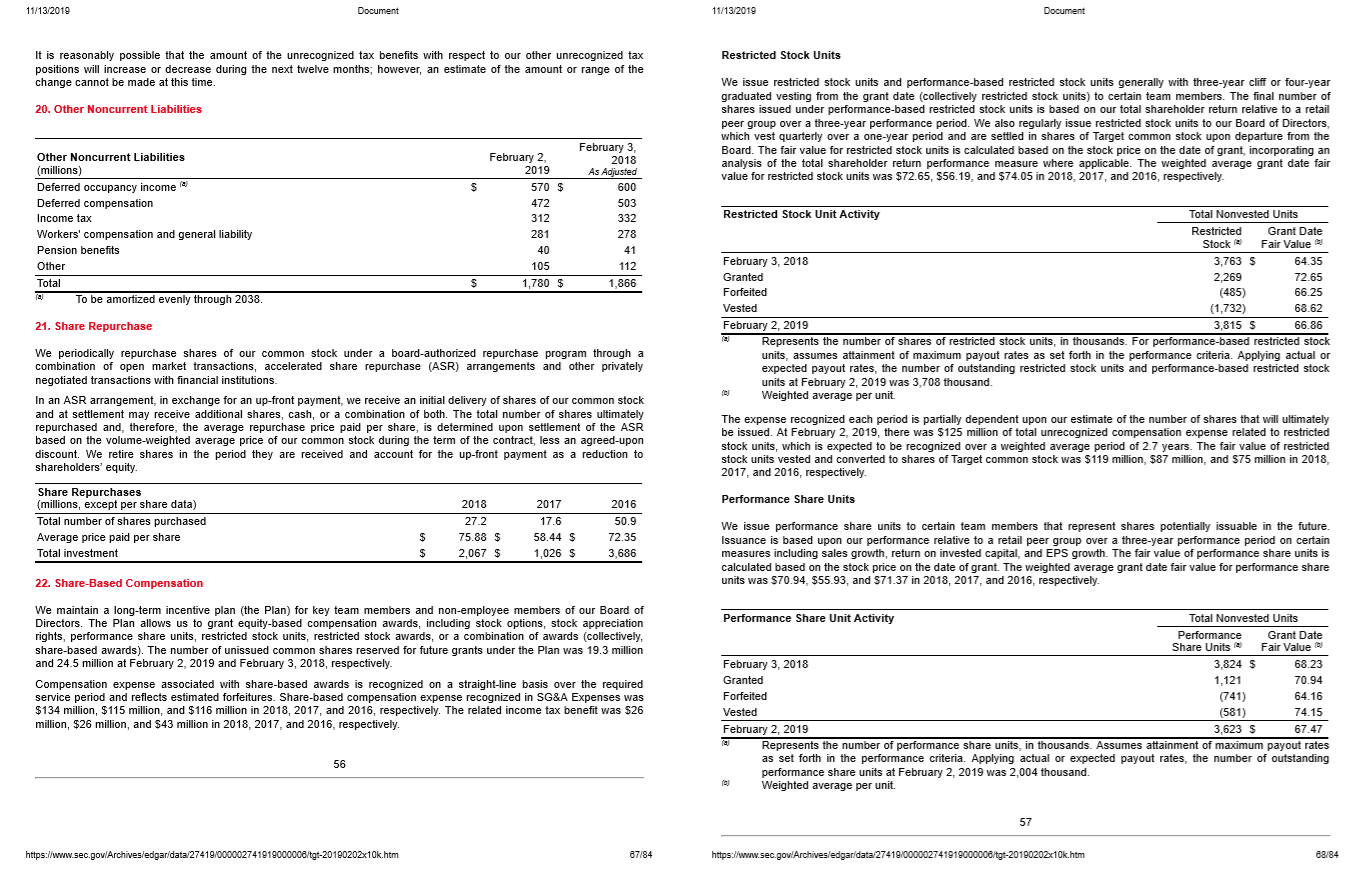
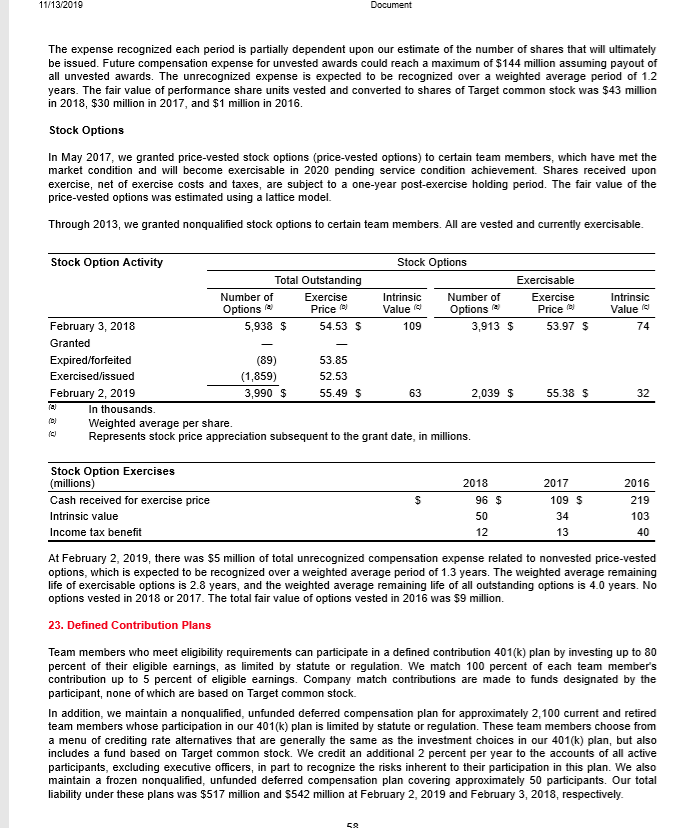
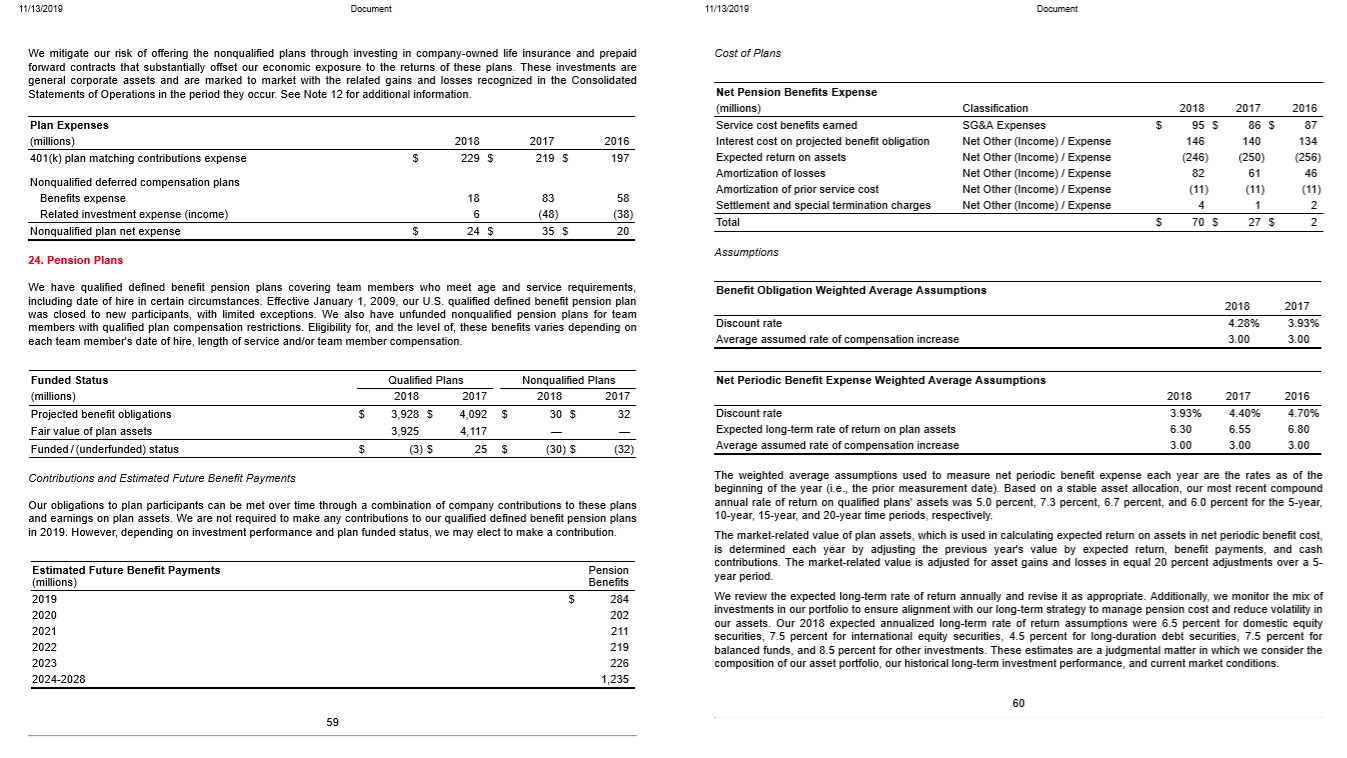
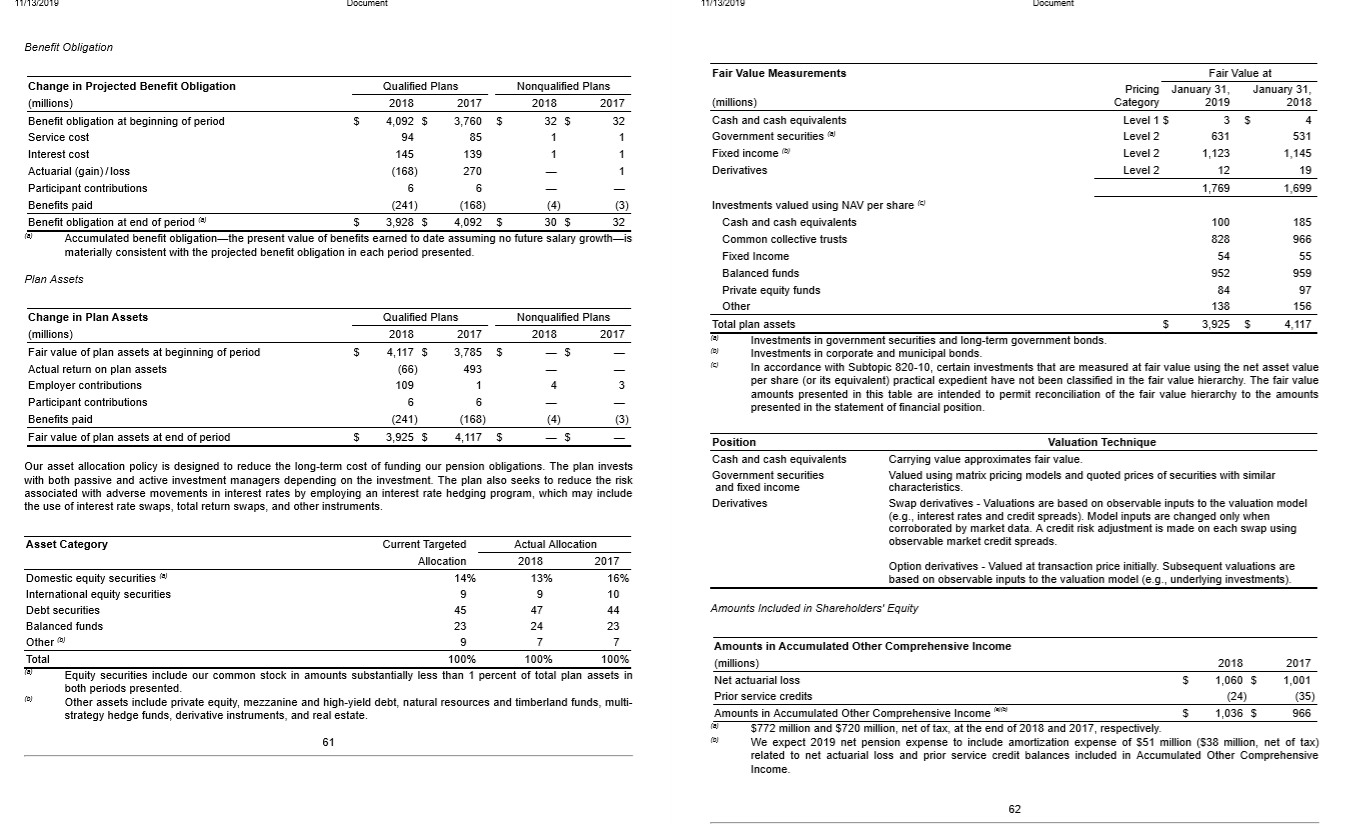
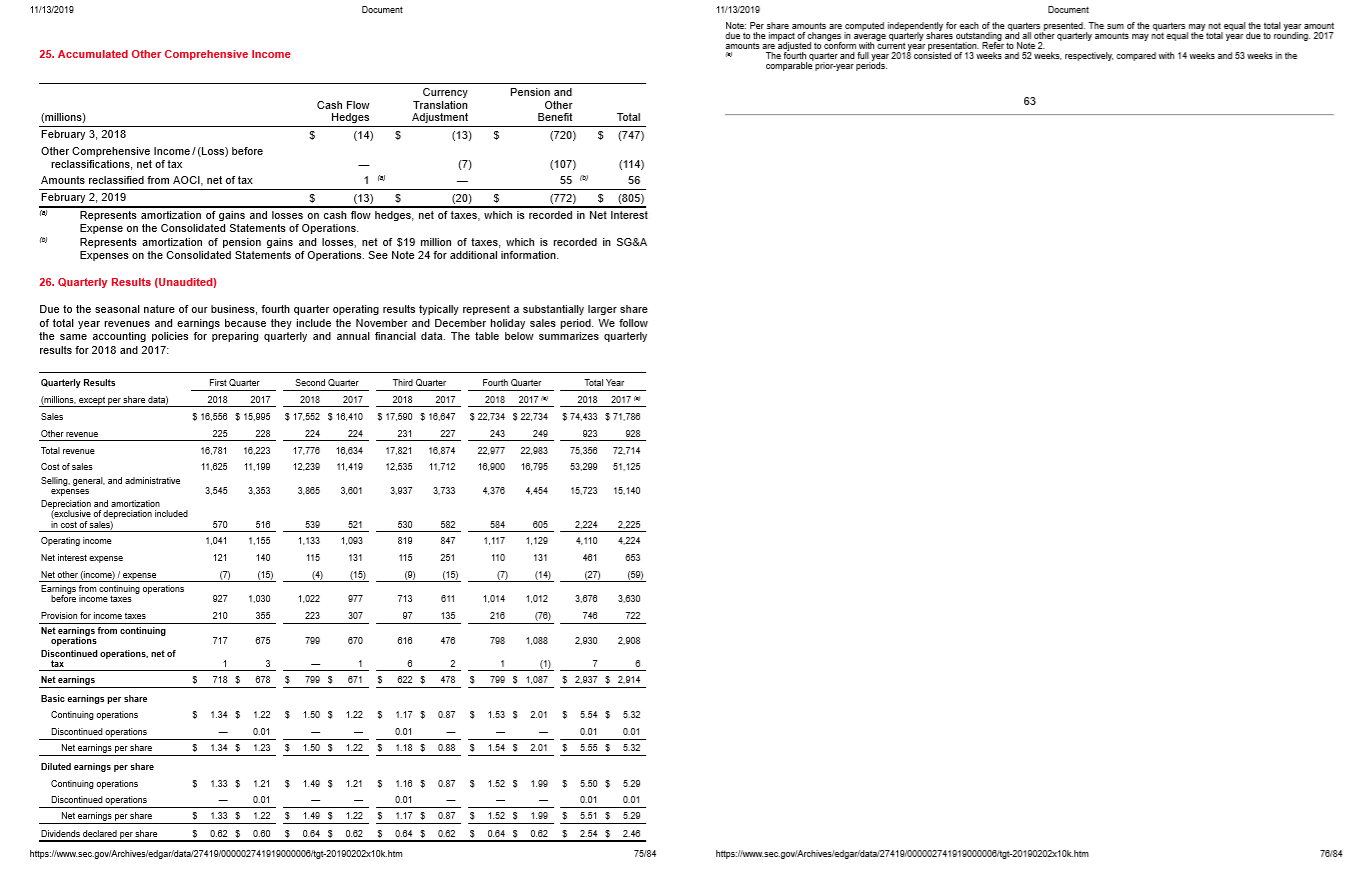 ?
?
Consolidated Statements of Operations (millions, except per share data) Sales Other revenue Total revenue Cost of sales Selling, general and administrative expenses Depreciation and amortization (exclusive of depreciation included in cost of sales) Operating income Net interest expense Net other (income) / expense Earnings from continuing operations before income taxes Provision for income taxes Net earnings from continuing operations Discontinued operations, net of tax Net earnings Basic earnings per share Continuing operations Discontinued operations Net earnings per share Diluted earnings per share Continuing operations Discontinued operations Net earnings per share Weighted average common shares outstanding Basic Diluted Antidilutive shares Note: Per share amounts may not foot due to rounding. See accompanying Notes to Consolidated Financial Statements. $ 69 35 $ 69 $ $ 9 69 $ $ 2018 74,433 S 923 75,356 53,299 15,723 2,224 4,110 461 (27) 3,676 746 2,930 7 2,937 $ 5.54 $ 0.01 5.55 $ 5.50 $ 0.01 5.51 $ 528.6 533.2 2017 As Adjusted 71,786 $ 928 72,714 51,125 15,140 2,225 4,224 653 (59) 3,630 722 2,908 6 2,914 $ 5.32 $ 0.01 5.32 $ 5.29 $ 0.01 5.29 $ 546.8 550.3 4.1 2016 As Adjusted 69,414 857 70,271 49,145 14,217 2,045 4,864 991 (88) 3,961 1,295 2,666 68 2,734 4.61 0.12 4.73 4.58 0.12 4.69 577.6 582.5 0.1 Refer to Note 2 regarding the adoption of new accounting standards for revenue recognition, leases, and pensions. Consolidated Statements of Comprehensive Income 36 (millions) Net earnings Other comprehensive (loss)/income, net of tax Pension and other benefit liabilities, net of tax Currency translation adjustment and cash flow hedges, net of tax Other comprehensive (loss)/income Comprehensive income See accompanying Notes to Consolidated Financial Statements. Refer to Note 2 regarding the adoption of new accounting standards for revenue recognition, leases, and pensions. 69 2017 2018 As Adjusted 2,937 S $ (52) (6) (58) 2,879 S 2,914 $ 2016 As Adjusted 2,734 2 6 8 2,922 $ (13) 4 (9) 2,725 Consolidated Statements of Financial Position (millions, except footnotes) Assets Cash and cash equivalents Inventory Other current assets Total current assets Property and equipment Land Buildings and improvements Fixtures and equipment Computer hardware and software Construction-in-progress Accumulated depreciation Property and equipment, net Operating lease assets Other noncurrent assets Total assets Liabilities and shareholders' investment Accounts payable Accrued and other current liabilities Current portion of long-term debt and other borrowings Total current liabilities Long-term debt and other borrowings Noncurrent operating lease liabilities Deferred income taxes Other noncurrent liabilities Total noncurrent liabilities $ (8) $ $ February 2, 2019 1,556 $ 9,497 1,466 12,519 6,064 29,240 5,912 2,544 460 (18,687) 25,533 1,965 1,273 41,290 $ 9,761 $ 4,201 1,052 15,014 10,223 2,004 972 1,780 14,979 43 6,042 6,017 February 3, 2018 As Adjusted (805) 2,643 8,597 1,300 12,540 6,095 28,131 5,623 2,645 440 (18,398) 24,536 1,884 1,343 40,303 8,677 4,094 281 Shareholders' investment Common stock Additional paid-in capital Retained earnings Accumulated other comprehensive loss Total shareholders' investment 11,297 Total liabilities and shareholders' investment $ 41,290 $ 40,303 Common Stock Authorized 6,000,000,000 shares, $0.0833 par value; 517,761,600 shares issued and outstanding at February 2, 2019; 541,681,670 shares issued and outstanding at February 3, 2018. 13,052 11,117 1,924 693 1,866 15,600 45 5,858 6,495 (747) 11,651 Preferred Stock Authorized 5,000,000 shares, $0.01 par value; no shares were issued or outstanding at February 2, 2019 or February 3, 2018. See accompanying Notes to Consolidated Financial Statements. Refer to Note 2 regarding the adoption of new accounting standards for revenue recognition, leases, and pensions. Consolidated Statements of Cash Flows (millions) Operating activities Net earnings Earnings from discontinued operations, net of tax Net earnings from continuing operations Adjustments to reconcile net earnings to cash provided by operations: Depreciation and amortization Share-based compensation expense Deferred income taxes Loss on debt extinguishment Noncash losses/(gains) and other, net Changes in operating accounts: Inventory Other assets Accounts payable Accrued and other liabilities Cash provided by operating activities-continuing operations Cash provided by operating activities-discontinued operations Cash provided by operations Investing activities Expenditures for property and equipment Proceeds from disposal of property and equipment Cash paid for acquisitions, net of cash assumed Other investments Cash required for investing activities Financing activities Additions to long-term debt Reductions of long-term debt Dividends paid Repurchase of stock Stock option exercises Cash required for financing activities Net (decrease) / increase in cash and cash equivalents Cash and cash equivalents at beginning of period Cash and cash equivalents at end of period Supplemental information Interest paid, net of capitalized interest Income taxes paid Leased assets obtained in exchange for new finance lease liabilities Leased assets obtained in exchange for new operating lease liabilities See accompanying Notes to Consolidated Financial Statements. $ $ 2017 2018 As Adjusted 2,937 $ 7 2,930 2,474 132 322 95 (900) (299) 1,127 89 5,970 3 5,973 (3,516) 85 15 (3.416) (281) (1,335) (2.124) 98 (3,644) (1,087) 2,843 1,550 $ 476 $ 373 130 246 2,914 $ 6 2,908 2,476 112 (188) 123 208 (348) (156) 1,307 419 6,861 74 6,935 (2,533) 31 (518) (55) (3,075) 739 (2,192) (1,338) (1,040) 108 (3,729) 131 2,512 2,643 $ 678 $ 934 139 212 2016 As Adjusted 2,734 68 2.886 2,318 113 40 422 (11) 293 56 (166) (394) 5,337 107 5,444 (1.547) 46 28 (1.473) 1,977 (2.649) (1.348) (3.706) 221 (5,505) (1.534) 4,046 2,512 999 1,514 252 148 Refer to Note 2 regarding the adoption of new accounting standards for revenue recognition, leases, and pensions. Consolidated Statements of Shareholders' Investment (millions) January 30, 2016 Adoption of ASC Topic 842 (Leases) Net earnings Other comprehensive loss Dividends declared Repurchase of stock Stock options and awards January 28, 2017 Net earnings Other comprehensive income Dividends declared Repurchase of stock Stock options and awards Reclassification of tax effects to retained earnings February 3, 2018 Net earnings Other comprehensive loss Dividends declared Repurchase of stock Stock options and awards February 2, 2019 Stock Par Shares Value 602.2 $ 50 $ Common Stock (50.9) 4.9 |||||||||| (17.6) 3.1 (4) 556.2 $ 46 $ 541.7 $ 45 $ (27.2) 3.3 517.8 $ 43 S Additional Paid-in Capital 5,348 $ 313 5,661 $ 197 5,858 $ 184 6,042 $ Retained Accumulated Other Comprehensive Earnings (Loss)/Income As Adjusted 8,196 $ (43) 2,734 (1,359) (3,682) 5,846 S 2,914 (1,356) (1,026) - 117 6,495 $ 2,937 - (1,347) (2,068) Total (629) $ 12,965 | | (9) 8 (43) (638) $ 10,915 2,914 8 (1,356) (1,027) 197 (58) 2,734 (9) (1,359) (3,686) 313 (117) (747) $ 11,651 2,937 - (58) (1,347) (2,070) 184 (805) $ 11,297 6,017 $ We declared $2.54, $2.46, and $2.36 dividends per share for the twelve months ended February 2, 2019, February 3, 2018, and January 28, 2017, respectively. See accompanying Notes to Consolidated Financial Statements. Refer to Note 2 regarding the adoption of new accounting standards for revenue recognition, leases, and pensions. Notes to Consolidated Financial Statements 1. Summary of Accounting Policies Organization We are a general merchandise retailer selling products to our guests through our stores and digital channels. We operate as a single segment that includes all of our continuing operations, which are designed to enable guests to purchase products seamlessly in stores or through our digital channels. Nearly all of our revenues are generated in the United States (U.S.). The vast majority of our long-lived assets are located within the U.S. Consolidation The consolidated financial statements include the balances of Target and its subsidiaries after elimination of intercompany balances and transactions. All material subsidiaries are wholly owned. We consolidate variable interest entities where it has been determined that Target is the primary beneficiary of those entities' operations. Use of estimates The preparation of our consolidated financial statements in conformity with U.S. generally accepted accounting principles (GAAP) requires management to make estimates and assumptions affecting reported amounts in the consolidated financial statements and accompanying notes. Actual results may differ significantly from those estimates. Fiscal year Our fiscal year ends on the Saturday nearest January 31. Unless otherwise stated, references to years in this report relate to fiscal years, rather than to calendar years. Fiscal 2018 ended February 2, 2019, and consisted of 52 weeks. Fiscal 2017 ended February 3, 2018, and consisted of 53 weeks. Fiscal 2016 ended January 28, 2017, and consisted of 52 weeks. Fiscal 2019 will end February 1, 2020, and will consist of 52 weeks. Accounting policies Our accounting policies are disclosed in the applicable Notes to the Consolidated Financial Statements. Certain prior-year amounts have been reclassified to conform to the current year presentation. Note 2 provides information about our adoption of new accounting standards for revenue recognition, leases, and pensions. 2. Accounting Standards Adopted Revenue Recognition We adopted Accounting Standards Update (ASU) No. 2014-09-Revenue from Contracts with Customers (Topic 606), as amended, as of February 4, 2018, using the full retrospective approach. The new standard did not materially affect our consolidated net earnings, financial position, or cash flows. The new standard resulted in minor changes to the timing of recognition of revenues for certain promotional gift card programs. For 2017 and 2016, we reclassified profit-sharing income under our credit card program agreement to Other Revenue from Selling, General and Administrative Expenses (SG&A Expenses). In addition, we reclassified certain advertising, rental, and other miscellaneous revenues, none of which was individually significant, from Sales and SG&A Expenses to Other Revenue. Leases We adopted ASU No. 2016-02-Leases (Topic 842), as amended, as of February 4, 2018, using the modified retrospective approach. The modified retrospective approach provides a method for recording existing leases at adoption and in comparative periods that approximates the results of a full retrospective approach. In addition, we elected the package of practical expedients permitted under the transition guidance within the new standard, which among other things, allowed us to carry forward the historical lease classification. We also elected the practical expedient related to land easements, allowing us to carry forward our accounting treatment for land easements on existing agreements. In addition, we elected the hindsight practical expedient to determine the lease term for existing leases. Our election of the hindsight practical expedient resulted in the shortening of lease terms for certain existing leases and the useful lives of corresponding leasehold improvements. In our application of hindsight, we evaluated the performance of the leased stores and the associated markets in relation to our overall real estate strategies, which resulted in the determination that most renewal options would not be reasonably certain in determining the expected lease term. Adoption of the new standard resulted in the recording of additional net lease assets and lease liabilities of approximately $1.3 billion and $1.4 billion respectively, as of February 4, 2018. The difference between the additional lease assets and lease liabilities, net of the deferred tax impact, was recorded as an adjustment to retained earnings. The standard did not materially impact our consolidated net earnings and had no impact on cash flows. Pensions In 2018, we adopted ASU No. 2017-07-Compensation - Retirement Benefits (Topic 715) using the full retrospective approach. The new standard requires employers to disaggregate and present separately the current service cost component from the other components of net benefit cost within the Consolidated Statement of Operations. For 2017 and 2016, we reclassified $(59) million and $(88) million, respectively, of non-service cost components of net benefit cost to Net Other (Income)/Expense from SG&A Expenses on our Consolidated Statements of Operations. Effect of Accounting Standards Adoption on Consolidated Statement of Operations (millions, except per share data) (unaudited) Sales Other revenue Total revenue Cost of sales Selling. general and administrative expenses Depreciation and amortization (exclusive of depreciation included in cost of sales) Operating income Net interest expense Net other (income) / expense Earnings from continuing operations before income taxes Provision for income taxes Net earnings from continuing operations Discontinued operations, net of tax Net earnings Basic earnings per share Continuing operations Discontinued operations Net earnings per share Diluted earnings per share Continuing operations Discontinued operations 2017 As Previously Reported $ 71,879 $ $ $ $ $ 71,879 51,125 14,248 2,194 4,312 668 3,646 718 ASC Topic 606 (Revenue Recognition) 2,928 6 2,934 $ 5.35 0.01 5.38 5.32 0.01 (93) 928 835 835 |||||||N (2) 2 Effect of the Adoption of $ $ ASC Topic 842 (Leases) (2) 31 (b) (29) (13) (16) 8 (22) (6) (22) (b) $ $ ASU 2017-07 (Pension) 59 (59) (59) (c) $ 2017 As Adjusted $ $ $ $ 71,786 928 72,714 51.125 15,140 2,225 4,224 653 (59) 3,630 722 2,908 6 2,914 5.32 0.01 5.32 5.29 0.01 Net earnings per share $ 5.33 $ 5.29 Note: 2017 was a 53-week year. Per share amounts may not foot due to rounding. The sum of "As Previously Reported" amounts and effects of the adoption of the new standards may not equal "As Adjusted" amounts due to rounding. Footnote explanations are provided on page 42. Effect of Accounting Standards Adoption on Consolidated Statement of Operations (millions, except per share data) (unaudited) Sales Other revenue Total revenue Cost of sales Selling. general and administrative expenses Depreciation and amortization (exclusive of depreciation included in cost of sales) Operating income Net interest expense Net other (income) / expense Earnings from continuing operations before income taxes Provision for income taxes Net earnings from continuing operations Discontinued operations, net of tax Net earnings Basic earnings per share Continuing operations Discontinued operations Net earnings per share Diluted earnings per share Continuing operations Discontinued operations 2016 As Previously Reported $ $ $ $ $ 69,495 $ 69,495 49,145 13,356 2,025 4,969 1,004 3,965 1,298 2,6869 68 ASC Topic 606 (Revenue Recognition) 2,737 S 4.62 0.12 4.74 4.58 0.12 4.70 (80) 857 777 777 Effect of the Adoption of ASC Topic 842 (Leases) (8) $ (4) 20 (16) (13) (3) (1) (2) (5) (5) $ (2) $ ASU 2017-07 (Pension) 88 (88) (88) $ $ $ 2016 As Adjusted $ $ 69,414 857 70,271 49.145 14,217 2,045 4,864 991 (88) 3,961 1.295 2,866 68 2,734 4.61 0.12 4.73 4.58 0.12 $ 4.69 Net earnings per share Note: Per share amounts may not foot due to rounding. The sum of "As Previously Reported" amounts and effects of the adoption of the new standards may not equal "As Adjusted" amounts due to rounding. For 2017 and 2016, we reclassified $694 million and $663 million, respectively, of profit-sharing income under our credit card program agreement to Other Revenue from SG&A Expenses. In addition, we reclassified certain advertising, rental, and other miscellaneous revenues, none of which was individually significant, from Sales and SG&A Expenses to Other Revenue. Relates to lease-term changes under the hindsight practical expedient. Relates to non-service cost components reclassified to Net Other (Income) / Expense from SG&A Expenses. Effect of Accounting Standards Adoption on Consolidated Statement of Financial Position (millions) (unaudited) Assets Cash and cash equivalents Inventory Other current assets Total current assets Property and equipment Land Accumulated depreciation Property and equipment, net Operating lease assets Other noncurrent assets Total assets Liabilities and shareholders' investment Accounts payable Accrued and other current liabilities Buildings and improvements Fixtures and equipment Computer hardware and software Construction-in-progress Current portion of long-term debt and other borrowings Total current liabilities Long-term debt and other borrowings Noncurrent operating lease liabilities Deferred income taxes Other noncurrent liabilities Total noncurrent liabilities na Z (4) (00 $ $ $ February 3, 2018 As Previously Reported 2,643 8,657 1,264 12,564 6,095 28,396 5,623 2,645 440 (18,181) 25,018 1,417 38,999 $ 8,677 $ 4,254 270 13,201 11,317 713 2,059 14,089 $ 45 5,858 6,553 (747) Effect of the Adoption of ASC Topic 608 (Revenue Recognition) (60) 60 (4) (14) (14) | 10 $ 10 $ $ ASC Topic 842 (Leases) (24) (24) (265) (217) (482) 1,884 (74) e 1,304 $ (146) 11 (135) (200) 1,924 (24) (192) 1,508 $ 10 (69) $ February 3, 2018 As Adjusted Shareholders' investment Common stock Additional paid-in capital Retained earnings Accumulated other comprehensive loss Total shareholders' investment 11,709 (69) $ 38,999 $ Total liabilities and shareholders' investment $ 1,304 Note: The sum of "As Previously Reported" amounts and effects of the adoption of the new standards may not equal "As Adjusted" amounts due to rounding. Represents estimated merchandise returns, which were reclassified from Inventory to Other Current Assets. Represents prepaid rent reclassified to Operating Lease Assets. Represents impact of changes in finance lease terms and related leasehold improvements (net of accumulated depreciation) under the hindsight practical expedient and derecognition of approximately $135 million of non- Target owned properties that were consolidated under previously existing build-to-suit accounting rules. Represents capitalization of operating lease assets and reclassification of leasehold acquisition costs, straight-line rent accrual, and tenant incentives. 2,643 8,597 1,300 12,540 6,095 28,131 5,623 2,645 440 (18,398) 24,536 1,884 1,343 40,303 8,677 4,094 281 13,052 11,117 1,924 693 1,866 15,600 45 5,858 6,495 (747) 11,651 $ 40,303 11/13/2019 Revenue from Target gift card sales is recognized upon gift card redemption, which is typically within one year of issuance. Our gift cards do not expire. Based on historical redemption rates, a small and relatively stable percentage of gift cards will never be redeemed, referred to as "breakage." Estimated breakage revenue is recognized over time in proportion to actual gift card redemptions. $ Document February 3, 2018 727 S Cost of Sales Total cost of products sold including Freight expenses associated with moving merchandise from our vendors to and between our distribution centers and our retail stores Vendor income that is not reimbursement of specific, incremental, and identifiable costs Gift Cards Issued During Current Period But Not Redeemed (4) 645 $ (millions) Gift card liability (a)Net of estimated breakage Guests receive a 5 percent discount on nearly all purchases and receive free shipping at Target.com when they use their Target Debit Card, Target Credit Card, or Target MasterCard (REDcards). The discount is included as a sales reduction in our Consolidated Statements of Operations and was $953 million, $933 million, and $899 million in 2018, 2017, and 2016, respectively. Revenue Recognized From Beginning Liability (532) $ Credit card profit sharing - We receive payments under a credit card program agreement with TD. Under the agreement, we receive a percentage of the profits generated by the Target Credit Card and Target MasterCard receivables in exchange for performing account servicing and primary marketing functions. TD underwrites, funds, and owns Target Credit Card and Target MasterCard receivables, controls risk management policies, and oversees regulatory compliance. Other - Includes rental income, advertising, membership fees, and other miscellaneous revenues, none of which are individually significant. 4. Cost of Sales and Selling, General and Administrative Expenses The following table illustrates the primary items classified in each major expense category: February 2, 2019 840 Selling, General and Administrative Expenses Compensation and benefit costs for stores and headquarters Inventory shrink Markdowns Outbound shipping and handling expenses associated with sales to our guests Payment term cash discounts Distribution center costs, including compensation and benefits costs and depreciation Import costs Note: The classification of these expenses varies across the retail industry. 45 Occupancy and operating costs of retail and headquarters facilities Advertising, offset by vendor income that is a reimbursement of specific, incremental, and identifiable costs Pre-opening and exit costs of stores and other facilities Credit cards servicing expenses Costs associated with accepting 3rd party bank issued payment cards Litigation and defense costs and related insurance recovery Other administrative costs 11/13/2019 5. Consideration Received from Vendors We receive consideration for a variety of vendor-sponsored programs, such as volume rebates, markdown allowances, promotions, and advertising allowances and for our compliance programs, referred to as "vendor income." Additionally, under our compliance programs, vendors are charged for merchandise shipments that do not meet our requirements (violations), such late or incomplete shipments. Substantially all consideration received is recorded as a reduction of Cost of Sales. We establish a receivable for vendor income that is earned but not yet received. Based on provisions of the agreements in place, this receivable is computed by estimating the amount earned when we have completed our performance. We perform detailed analyses to determine the appropriate level of the receivable in the aggregate. The majority of year-end receivables associated with these activities are collected within the following fiscal quarter. We have not historically had significant write-offs for these receivables. 6. Advertising Costs Advertising costs, which primarily consist of newspaper circulars, digital advertisements, and media broadcast, are generally expensed at first showing or distribution of the advertisement. Advertising Costs (millions) Gross advertising costs Vendor income Net advertising costs Fair Value Measurements - Recurring Basis (millions) Assets Document Short-term investments Prepaid forward contracts Interest rate swaps Liabilities Al (2) Classification Cash and Cash Equivalents Other Current Assets Other Noncurrent Assets $ 7. Fair Value Measurements Fair value measurements are reported in one of three levels based on the lowest level of significant input used: Level 1 (unadjusted quoted prices in active markets); Level 2 (observable market inputs, other than quoted prices included in Level 1); and Level 3 (unobservable inputs that cannot be corroborated by observable market data). 46 $ 2018 1,494 $ 1,494 S 2017 1,476 $ (19) 1,457 S Level 1 $ Level 1 Level 2 Level 2 Level 2 Fair Value at Pricing February 2, February 3, Category 2018 2019 769 19 10 2016 1,503 (38) $ 3 1,465 Interest rate swaps Other Current Liabilities Interest rate swaps Other Noncurrent Liabilities Carrying value approximates fair value because maturities are less than three months. Initially valued at transaction price. Subsequently valued by reference to the market price of Target common stock. Valuations are based on observable inputs to the valuation model (e.g., interest rates and credit spreads). See Note 17 for additional information on interest rate swaps. 1,906 23 6 11/13/2019 (10) Document Significant Financial Instruments not Measured at Fair Value ( (millions) Long-term debt, including current portion $ 10,247 $ 10,808 $ 10,440 $ 11,155 The carrying amounts of certain other current assets, commercial paper, accounts payable, and certain accrued and other current liabilities approximate fair value due to their short-term nature. 2018 (millions) Carrying Amount The fair value of debt is generally measured using a discounted cash flow analysis based on current market interest rates for the same or similar types of financial instruments and would be classified as Level 2. These amounts exclude commercial paper, unamortized swap valuation adjustments, and lease liabilities. Cash Short-term investments Receivables from third-party financial institutions for credit and debit card transactions Cash and cash equivalents (a) We have access to these funds without any significant restrictions, taxes or penalties. Other Current Assets (millions) Income tax and other receivables Vendor income receivable Prepaid expenses Other Total 8. Cash and Cash Equivalents Cash equivalents include highly liquid investments with an original maturity of three months or less from the time of purchase. Cash equivalents also include amounts due from third-party financial institutions for credit and debit card transactions. These receivables typically settle in five days or less. Fair Value $ $ Carrying Fair Amount Value February 2, 2019 $ 2017 $ 359 $ 769 428 1,556 $ At February 2, 2019 and February 3, 2018, we reclassified book overdrafts of $242 million and $358 million, respectively, to Accounts Payable and $25 million and $29 million, respectively, to Accrued and Other Current Liabilities. 9. Inventory The vast majority of our inventory is accounted for under the retail inventory accounting method (RIM) using the last-in, first-out (LIFO) method. Inventory is stated at the lower of LIFO cost or market. Inventory cost includes the amount we pay to our suppliers to acquire inventory, freight costs incurred to deliver product to our distribution centers and stores, and import costs, reduced by vendor income and cash discounts. Distribution center operating costs, including compensation and benefits, are expensed in the period incurred. Inventory is also reduced for estimated losses related to shrink and markdowns. The LIFO provision is calculated based on inventory levels, markup rates, and internally measured retail price indices. February 3, 2018 Under RIM, inventory cost and the resulting gross margins are calculated by applying a cost-to-retail ratio to the inventory retail value. RIM is an averaging method that has been widely used in the retail industry due to its practicality. The use of RIM will result in inventory being valued at the lower of cost or market because permanent markdowns are taken as a reduction of the retail value of inventory. 10. Other Current Assets February 2, 2019 632 $ 468 157 209 1,466 $ 337 1,906 400 2,643 February 3, 2018 As Adjusted 513 416 157 214 1,300 11/13/2019 11. Property and Equipment Property and equipment, including assets acquired under finance leases, is depreciated using the straight-line method over estimated useful lives or lease terms if shorter. We amortize leasehold improvements purchased after the beginning of the initial lease term over the shorter of the assets' useful lives or a term that includes the original lease term, plus any renewals that are reasonably certain at the date the leasehold improvements are acquired. Depreciation expense for 2018, 2017, and 2016 was $2,460 million, $2,462 million, and $2,305 million, respectively, including depreciation expense included in Cost of Sales. For income tax purposes, accelerated depreciation methods are generally used. Repair and maintenance costs are expensed as incurred. Facility pre-opening costs, including supplies and payroll, are expensed as incurred. Estimated Useful Lives Buildings and improvements Fixtures and equipment Computer hardware and software 12. Other Noncurrent Assets We review long-lived assets for impairment when events or changes in circumstances such as a decision to relocate or close a store or distribution center, make significant software changes or discontinue projects-indicate that the asset's carrying value may not be recoverable. We recognized impairment losses of $92 million, $91 million, and $43 million during 2018, 2017, and 2016, respectively. The impairment losses primarily resulted from planned or completed store closures, and for 2017, supply chain changes. For asset groups classified as held for sale, the carrying value is compared with the fair value less cost to sell. We estimate fair value by obtaining market appraisals, valuations from third party brokers, or other valuation techniques. Impairments are recorded in SG&A Expenses on the Consolidated Statements of Operations. Other Noncurrent Assets (millions) Document Goodwill and intangible assets Company-owned life insurance investments, net of loans Pension asset Other Total $ 48 $ Life (Years) 8-39 2-15 2-7 February 2, 2019 699 $ 380 11 183 1,273 $ February 3, 2018 As Adjusted 709 383 46 205 1,343 13. Goodwill and Intangible Assets Goodwill totaled $633 million and $630 million at February 2, 2019 and February 3, 2018, respectively. In December 2017, we acquired Shipt, Inc., an online same-day delivery service platform, for approximately $550 million. We identified intangible assets of $40 million, primarily related to the tradename, customer relationships, and shopper lists, net tangible assets of $10 million, and goodwill of $500 million. The goodwill recorded primarily represents the value of significantly accelerating our ability to provide same-day delivery services to our guests. No impairments were recorded in 2018, 2017, or 2016 as a result of the annual goodwill impairment tests performed. Intangible assets, net of accumulated amortization, totaled $66 million and $79 million as of February 2, 2019, and February 3, 2018, respectively, primarily related to trademarks and customer relationships. We use both accelerated and straight-line methods to amortize definite-lived intangible assets over 4 to 15 years. The weighted average life of intangible assets was 8 years at February 2, 2019. Amortization expense was $14 million, $14 million, and $13 million in 2018, 2017, and 2016, respectively, and is estimated to be less than $15 million annually through 2023. 11/13/2019 14. Accrued and Other Current Liabilities Accrued and Other Current Liabilities (millions) Wages and benefits Gift card liability, net of estimated breakage Real estate, sales, and other taxes payable Dividends payable Current portion of operating lease liabilities Workers' compensation and general liability Interest payable Other Total Document $ February 2, 2019 1,229 $ 840 601 331 166 166 49 in 142 February 3, 2018 As Adjusted 1,209 727 670 336 336 118 148 ^^^ 141 62 62 830 4,201 $ $ We retain a substantial portion of the risk related to general liability and workers' compensation claims. We estimate our ultimate cost based on analysis of historical data and actuarial estimates. General liability and workers' compensation liabilities are recorded at our estimate of their net present value. 15. Commitments and Contingencies 67 67 796 4,094 Contingencies We are exposed to claims and litigation arising in the ordinary course of business and use various methods to resolve these matters in a manner that we believe serves the best interest of our shareholders and other constituents. When a loss probable, we record an accrual based on the reasonably estimable loss or range of loss. When no point of loss is more likely than another, we record the lowest amount in the estimated range of loss and, if material, disclose the estimated range of loss. We do not record liabilities for reasonably possible loss contingencies, but do disclose a range of reasonably possible losses if they are material and we are able to estimate such a range. If we cannot provide a range of reasonably possible losses, we explain the factors that prevent us from determining such a range. Historically, adjustments to our estimates have not been material. We believe the recorded reserves in our consolidated financial statements are adequate in light of the probable and estimable liabilities. We do not believe that any of these identified claims or litigation will be material to our results of operations, cash flows, or financial condition. Commitments Purchase obligations, which include all legally binding contracts such as firm commitments for inventory purchases, merchandise royalties, equipment purchases, marketing-related contracts, software acquisition/license commitments, and service contracts, were $992 million and $1,225 million at February 2, 2019 and February 3, 2018, respectively. These purchase obligations are primarily due within three years and recorded as liabilities when goods are received or services rendered. Real estate obligations, which include legally binding minimum lease payments for leases signed but not yet commenced, and commitments for the purchase, construction, or remodeling of real estate and facilities, were $1,134 million and $1,110 million at February 2, 2019 and February 3, 2018, respectively. Over half of these real estate obligations are due within five years, a portion of which are recorded as liabilities. We issue letters of credit and surety bonds in the ordinary course of business. Trade letters of credit totaled $1,746 million and $1,757 million at February 2, 2019 and February 3, 2018, respectively, a portion of which are reflected in accounts payable. Standby letters of credit and surety bonds, relating primarily to insurance and regulatory requirements, totaled $403 million and $372 million at February 2, 2019 and February 3, 2018, respectively. 11/13/2019 16. Commercial Paper and Long-Term Debt At February 2, 2019, the carrying value and maturities of our debt portfolio were as follows: Debt Maturities (dollars in millions) Due 2019-2023 Due 2024-2028 Due 2029-2033 Due 2034-2038 Due 2039-2043 Due 2014-2018 Due 2044-2048 Total notes and debentures Swap valuation adjustments Finance lease liabilities Less: Amounts due within one year Long-term debt and other borrowings 781 Reflects the weighted average stated interest rate as of year-end. Required Principal Payments (millions) Total required principal payments Document Commercial Paper (dollars in millions) 2019 $ 1,002 $ Maximum daily amount outstanding during the year Average amount outstanding during the year Amount outstanding at year-end Weighted average interest rate 2020 1,094 $ 2021 1,056 $ 50 $ In October 2017, we issued unsecured fixed rate debt of $750 million at 3.9 percent that matures in November 2047. In addition to debt repaid at its maturity during 2017, during October 2017, we repurchased $344 million of debt before its maturity at a market value of $463 million. We recognized a loss on early retirement of approximately $123 million, which was recorded in Net Interest Expense in our Consolidated Statements of Operations. 2018 February 2, 2019 Rate( Balance 3,207 2,179 561 1,109 1,465 1,726 10.247 In April 2016, we issued unsecured fixed rate debt of $1 billion at 2.5 percent that matures in April 2026 and $1 billion at 3.625 percent that matures in April 2046. In addition to debt repaid at its maturity during 2016, during the first half of 2016, we repurchased $1,389 million of debt before its maturity at a market value of $1,800 million. We recognized a loss on early retirement of approximately $422 million, which was recorded in Net Interest Expense in our Consolidated Statements of Operations. We obtain short-term financing from time to time under our commercial paper program. 658 $ 63 3.4% $ 3.3 6.6 6.8 4.0 3.7 4.1 2.00% 2022 63 $ $ 2017 -% 7 1,021 (1,052) 10,223 2023 $ 2016 89 1 0.43% In October 2018, we extended a committed $2.5 billion revolving credit facility by one year to October 2023. No balances were outstanding under our credit facility at any time during 2018, 2017, or 2016. Substantially all of our outstanding borrowings are senior, unsecured obligations. Most of our long-term debt obligations contain covenants related to secured debt levels. In addition to a secured debt level covenant, our credit facility also contains a debt leverage covenant. We are, and expect to remain, in compliance with these covenants, which have no practical effect on our ability to pay dividends. 11/13/2019 17. Derivative Financial Instruments Document Our derivative instruments primarily consist of interest rate swaps, which we use to mitigate interest rate risk. As a result of our use of derivative instruments, we have counterparty credit exposure to large global financial institutions. We monitor this concentration of counterparty credit risk on an ongoing basis. Note 7 provides the fair value and classification of these instruments. During 2018, we entered into two interest rate swaps, each with a notional amount of $250 million, under which we pay a variable rate and receive a fixed rate. We designated these swaps as fair value hedges. Under the swap agreements, we pay a floating rate equal to 1-month London Interbank Offered Rate (LIBOR) and receive a weighted average fixed rate of 2.9 percent. The agreements have a weighted average remaining maturity of 6.3 years. Under the two previously existing swap agreements, which mature during 2019, we pay a floating rate equal to 3-month LIBOR and receive a weighted average fixed rate of 1.8 percent. With the addition of the two swaps entered into during 2018, as of February 2, 2019, four interest rate swaps with notional amounts totaling $1,500 million were designated as fair value hedges. As of February 3, 2018, two interest rate swaps with notional amounts totaling $1,000 million were designated as fair value hedges. No ineffectiveness was recognized in 2018 or 2017. $10 million f interest rate swap-related assets were classified within Other Noncurrent Assets and $3 million of interest rate swap-related liabilities were classified within Other Current Liabilities as of February 2, 2019. $6 million of designated interest rate swap-related liabilities were classified within Other Noncurrent Liabilities as of February 3, 2018. We recorded expense of $3 million during 2018 and income of $9 million and $24 million during 2017 and 2016, respectively, within Net Interest Expense on our Consolidated Statements of Operations related to periodic payments, valuation adjustments, and amortization of gains or losses on our interest rate swaps. 18. Leases We lease certain retail stores, warehouses, distribution centers, office space, land, and equipment. Leases with an initial term of 12 months or less are not recorded on the balance sheet; we recognize lease expense for these leases on a straight-line basis over the lease term. For lease agreements entered into or reassessed after the adoption of Topic 842, we combine lease and nonlease components. Most leases include one or more options to renew, with renewal terms that can extend the lease term from one to 50 years or more. The exercise of lease renewal options is at our sole discretion. Certain leases also include options to purchase the leased property. The depreciable life of assets and leasehold improvements are limited by the expected lease term, unless there is a transfer of title or purchase option reasonably certain of exercise. Certain of our lease agreements include rental payments based on a percentage of retail sales over contractual levels and others include rental payments adjusted periodically for inflation. Our lease agreements do not contain any material residual value guarantees or material restrictive covenants. We rent or sublease certain real estate to third parties. Our lease and sublease portfolio consists mainly of operating leases with CVS Pharmacy Inc. (CVS) for space within our stores. 51 11/13/2019 Leases (millions) Assets Operating Finance Total leased assets Liabilities Current Operating Finance Noncurrent Operating Finance Lease Cost (millions) Operating lease cost Finance lease cost Classification (0) (4) Operating Lease Assets Buildings and Improvements, net of Accumulated Depreciation (2) Document Accrued and Other Current Liabilities Current Portion of Long-term Debt and Other Borrowings Noncurrent Operating Lease Liabilities Long-term Debt and Other Borrowings Classification SG&A Expenses Depreciation and Amortization Net Interest Expense Other Revenue 52 $ 2018 February 2, 2019 $ $ 2,004 968 Total lease liabilities $ 3,191 $ Note: As most of our leases do not provide an implicit rate, we use our incremental borrowing rate based on the information available at commencement date in determining the present value of lease payments. We use the incremental borrowing rate on January 31, 2016, for operating leases that commenced prior to that date. Finance lease assets are recorded net of accumulated amortization of $371 million and $317 million as of February 2, 2019 and February 3, 2018, respectively. $ 251 $ 65 42 (11) 347 S 1,965 $ 872 2,837 $ 166 $ 53 2017 221 $ 63 42 February 3, 2018 1,884 836 (9) 317 $ 2,720 148 80 Amortization of leased assets Interest on lease liabilities Sublease income Net lease cost $ Includes short-term leases and variable lease costs, which are immaterial. Supply chain-related amounts are included in Cost of Sales. Sublease income excludes rental income from owned properties of $47 million for 2018, 2017, and 2016, which is included in Other Revenue. 1,924 885 3,037 2016 199 87 36 (7) 315 11/13/2019 Maturity of Lease Liabilities (millions) 2019 2020 2021 **** 2022 2003 2023 After 2023 Total lease payments Less: Interest 245 $ 238 232 226 217 1716 1,746 2,904 $ 734 2,170 $ $ Present value of lease liabilities Operating lease payments include $778 million related to options to extend lease terms that are reasonably certain of being exercised and exclude $341 million of legally binding minimum lease payments for leases signed but not yet commenced. (0) Lease Term and Discount Rate Weighted average remaining lease term (years) Operating leases Finance leases Weighted average discount rate Operating leases Finance leases Document Other Information (millions) Cash paid for amounts included in the measurement of lease liabilities Operating cash flows from operating leases Operating cash flows from finance leases Financing cash flows from finance leases 19. Income Taxes $ Operating Leases $ Finance lease payments include $127 million related to options to extend lease terms that are reasonably certain of being exercised and exclude $193 million of legally binding minimum lease payments for leases signed but not yet commenced. 53 $ Finance Leases 2018 98 $ 98 98 99 94 074 974 1,461 $ 440 1,021 February 2, 2019 231 S 45 80 14.2 15.4 3.91% 4.64% Total 343 336 330 325 311 2017 2,720 4,365 198 $ 42 45 February 3, 2018 15.2 15.4 3.88% 4.64% 2016 188 36 94 In December 2017, the U.S. government enacted the Tax Cuts and Jobs Act tax reform legislation (the Tax Act), which among other matters reduced the U.S. corporate income tax rate from 35 percent to 21 percent effective January 1, 2018. In 2017, we recorded a provisional $343 million net tax benefit primarily related to the remeasurement of certain deferred tax assets and liabilities, including $372 million of benefit from the new lower rate, partially offset by $29 million of deferred income tax expense from our foreign operations. During 2018, we completed our Tax Act accounting and recorded adjustments to previously-recorded provisional amounts, resulting in a $36 million tax benefit primarily related to the remeasurement of deferred tax assets and liabilities. Beginning with 2018, we are subject to a new tax on global intangible low-taxed income that is imposed on foreign earnings. We have made an accounting election to record this tax as a period cost and thus have not adjusted any of the deferred tax assets or liabilities of our foreign subsidiaries for the new tax. Net impacts of this new tax were immaterial and are included in our provision for income taxes for 2018. 11/13/2019 Earnings from continuing operations before income taxes were $3,676 million, $3,630 million, and $3,961 million during 2018, 2017, and 2016, respectively, including $734 million, $722 million, and $336 million earned by our foreign entities subject to tax outside of the U.S. Tax Rate Reconciliation - Continuing Operations Federal statutory rate State income taxes, net of the federal tax benefit International Tax Act Excess tax benefit related to share-based payments Federal tax credits Other Provision for Income Taxes (millions) Current: Federal D State Inter International Total current 10.61 (0.6) (0.7) (1.1) Effective tax rate 19.9 % 32.7% Represents the discrete benefit of remeasuring our net deferred tax liabilities at the new lower U.S. corporate income tax rate. Deferred: Federal State Document International Total deferred Total provision 54 $ 2018 21.0 % 3.6 (1.3) (1.0) (0.3) $ (1.1) (0.6) 20.3 % 2017 As Adjusted 2018 257 $ 116 51 424 33.7% 2.2 (4.6) jo ry (9.5) 263 57 2 322 746 $ in 41 (0.1) (0.8) (1.0) 2017 As Adjusted 746 $ 105 59 910 2016 As Adjusted 35.0 % 2.7 (2.6) (229) 27 14 (188) 722 $ 2016 As Adjusted 1,108 141 6 1,255 20 21 (1) 40 1,295 11/13/2019 Net Deferred Tax Asset/(Liability) (millions) Gross deferred tax assets: Accrued and deferred compensation Accruals and reserves not currently deductible Self-insured benefits Deferred occupancy income Leased assets Leascu Other Suive Total gross deferred tax assets Gross deferred tax liabilities: Property and equipment Inventory Other Total Total net deferred tax liability gross deferred tax liabilities Document Reconciliation of Liability for Unrecognized Tax Benefits (millions) Balance at beginning of period Additions based on tax positions related to the current year Additions for tax positions of prior years Reductions for tax positions of prior years Settlements Balance at end of period $ $ 55 S February 2, 2019 248 S 181 114 157 2018 92 40 832 Deferred tax assets and liabilities are recognized for the future tax consequences attributable to temporary differences between financial statement carrying amounts of existing assets and liabilities and their respective tax bases. Deferred tax assets and liabilities are measured using enacted income tax rates in effect for the year the temporary differences are expected to be recovered or settled. Tax rate changes affecting deferred tax assets and liabilities are recognized at the enactment date. We recognized a net tax benefit of $36 million and $372 million in 2018 and 2017, respectively, primarily because we remeasured our net deferred tax liabilities using the new lower U.S. corporate tax rate. (1,557) (140) (95) Beginning in 2017, due to changes effected by the Tax Act and other reasons, we have not asserted indefinite reinvestment in our foreign operations. Because of this change, we recorded a deferred tax charge of $29 million during 2017. 325 S 58 10 (91) (2) 300 S (1,792) (960) $ We file a U.S. federal income tax return and income tax returns in various states and foreign jurisdictions. The U.S. Internal Revenue Service has completed exams on the U.S. federal income tax returns for years 2015 and prior. With few exceptions, we are no longer subject to state and local or non-U.S. income tax examinations by tax authorities for years before 2009. February 3, 2018 As Adjusted 262 162 109 164 87 42 826 (1,264) (130) (91) (1,485) (659) 2017 153 $ 112 142 (71) (11) 325 $ 2016 153 12 6 (16) (2) 153 S If we were to prevail on all unrecognized tax benefits recorded, $252 million of the $300 million reserve would benefit the effective tax rate. In addition, the reversal of accrued penalties and interest would also benefit the effective tax rate. Interest and penalties associated with unrecognized tax benefits are recorded within income tax expense. During the years ended February 2, 2019, February 3, 2018, and January 28, 2017, we recorded an expense / (benefit) from accrued penalties and interest of $3 million, $(12) million, and $1 million, respectively. As of February 2, 2019, February 3, 2018, and January 28, 2017 total accrued interest and penalties were $32 million, $29 million, and $45 million, respectively. 11/13/2019 It is reasonably possible that the amount of the unrecognized tax benefits with respect to our other unrecognized tax positions will increase or decrease during the next twelve months; however, an estimate of the amount or range of the change cannot be made at this time. 20. Other Noncurrent Liabilities Other Noncurrent Liabilities (millions) Deferred occupancy income Deferred compensation Income tax Workers' compensation and general liability Pension benefits Other Total To be amortized evenly through 2038. Document Share Repurchases (millions, except per share data) Total number of shares purchased Average price paid per share Total investment $ 21. Share Repurchase We periodically repurchase shares of our common stock under a board-authorized repurchase program through a combination of open market transactions, accelerated share repurchase (ASR) arrangements and other privately negotiated transactions with financial institutions. 56 $ In an ASR arrangement, in exchange for an up-front payment, we receive an initial delivery of shares of our common stock and at settlement may receive additional shares, cash, or a combination of both. The total number of shares ultimately repurchased and, therefore, the average repurchase price paid per share, is determined upon settlement of the ASR based on the volume-weighted average price of our common stock during the term of the contract, less an agreed-upon discount. We retire shares in the period they are received and account for the up-front payment as a reduction to shareholders' equity. $ $ February 2 2019 570 $ 472 312 https://www.sec.gov/Archives/edgar/data/27419/000002741919000006/tgt-20190202x10k.htm 281 40 105 1,780 $ 2018 27.2 75.88 $ 2,067 $ February 3, 2018 As Adjusted 600 503 332 278 41 112 1,866 2017 17.6 58.44 $ 1,026 $ 22. Share-Based Compensation We maintain a long-term incentive plan (the Plan) for key team members and non-employee members of our Board of Directors. The Plan allows us to grant equity-based compensation awards, including stock options, stock appreciation rights, performance share units, restricted stock units, restricted stock awards, or a combination of awards (collectively, share-based awards). The number of unissued common shares reserved for future grants under the Plan was 19.3 million and 24.5 million at February 2, 2019 and February 3, 2018, respectively. 2016 50.9 72.35 3,686 Compensation expense associated with share-based awards is recognized on a straight-line basis over the required service period and reflects estimated forfeitures. Share-based compensation expense recognized in SG&A Expenses was $134 million, $115 million, and $116 million in 2018, 2017, and 2016, respectively. The related income tax benefit was $26 million, $26 million, and $43 million in 2018, 2017, and 2016, respectively. 67/84 11/13/2019 Restricted Stock Units We issue restricted stock units and performance-based restricted stock units generally with three-year cliff or four-year graduated vesting from the grant date (collectively restricted stock units) to certain team members. The final number of shares issued under performance-based restricted stock units is based on our total shareholder return relative to a retail peer group over a three-year performance period. We also regularly issue restricted stock units to our Board of Directors, which vest quarterly over a one-year period and are settled in shares of Target common stock upon departure from the Board. The fair value for restricted stock units is calculated based on the stock price on the date of grant, incorporating an analysis of the total shareholder return performance measure where applicable. The weighted average grant date fair value for restricted stock units was $72.65, $56.19, and $74.05 in 2018, 2017, and 2016, respectively. Restricted Stock Unit Activity February 3, 2018 Granted Forfeited Vested (2) 64.35 72.65 66.25 68.62 February 2, 2019 66.86 Represents the number of shares of restricted stock units, in thousands. For performance-based restricted stock units, assumes attainment of maximum payout rates as set forth in the performance criteria. Applying actual or expected payout rates, the number of outstanding restricted stock units and performance-based restricted stock units at February 2, 2019 was 3,708 thousand. Weighted average per unit. Performance Share Units Document Performance Share Unit Activity The expense recognized each period is partially dependent upon our estimate of the number of shares that will ultimately be issued. At February 2, 2019, there was $125 million of total unrecognized compensation expense related to restricted stock units, which is expected to be recognized over a weighted average period of 2.7 years. The fair value of restricted stock units vested and converted to shares of Target common stock was $119 million, $87 million, and $75 million in 2018, 2017, and 2016, respectively. February 3, 2018 Granted Forfeited Vested Total Nonvested Units Restricted Stock We issue performance share units to certain team members that represent shares potentially issuable in the future. Issuance is based upon our performance relative to a retail peer group over a three-year performance period on certain measures including sales growth, return on invested capital, and EPS growth. The fair value of performance share units is calculated based on the stock price on the date of grant. The weighted average grant date fair value for performance share units was $70.94, $55.93, and $71.37 in 2018, 2017, and 2016, respectively. (0) 3,763 S 2,269 (485) (1,732) 3,815 S 57 Grant Date Fair Value https://www.sec.gov/Archives/edgar/data/27419/000002741919000008/tgt-20190202x10k.htm Total Nonvested Units Performance Grant Date Fair Value Share Units (2) 3,824 S 1,121 (741) (581) 3,623 S February 2, 2019 Represents the number of performance share units, in thousands. Assumes attainment of maximum payout rates as set forth in the performance criteria. Applying actual or expected payout rates, the number of outstanding performance share units at February 2, 2019 was 2,004 thousand. Weighted average per unit. 68.23 70.94 64.16 74.15 67.47 68/84 11/13/2019 It is reasonably possible that the amount of the unrecognized tax benefits with respect to our other unrecognized tax positions will increase or decrease during the next twelve months; however, an estimate of the amount or range of the change cannot be made at this time. 20. Other Noncurrent Liabilities Other Noncurrent Liabilities (millions) Deferred occupancy income Deferred compensation Income tax Workers' compensation and general liability Pension benefits Other Total To be amortized evenly through 2038. Document Share Repurchases (millions, except per share data) Total number of shares purchased Average price paid per share Total investment $ 21. Share Repurchase We periodically repurchase shares of our common stock under a board-authorized repurchase program through a combination of open market transactions, accelerated share repurchase (ASR) arrangements and other privately negotiated transactions with financial institutions. 56 $ In an ASR arrangement, in exchange for an up-front payment, we receive an initial delivery of shares of our common stock and at settlement may receive additional shares, cash, or a combination of both. The total number of shares ultimately repurchased and, therefore, the average repurchase price paid per share, is determined upon settlement of the ASR based on the volume-weighted average price of our common stock during the term of the contract, less an agreed-upon discount. We retire shares in the period they are received and account for the up-front payment as a reduction to shareholders' equity. $ $ February 2 2019 570 $ 472 312 https://www.sec.gov/Archives/edgar/data/27419/000002741919000006/tgt-20190202x10k.htm 281 40 105 1,780 $ 2018 27.2 75.88 $ 2,067 $ February 3, 2018 As Adjusted 600 503 332 278 41 112 1,866 2017 17.6 58.44 $ 1,026 $ 22. Share-Based Compensation We maintain a long-term incentive plan (the Plan) for key team members and non-employee members of our Board of Directors. The Plan allows us to grant equity-based compensation awards, including stock options, stock appreciation rights, performance share units, restricted stock units, restricted stock awards, or a combination of awards (collectively, share-based awards). The number of unissued common shares reserved for future grants under the Plan was 19.3 million and 24.5 million at February 2, 2019 and February 3, 2018, respectively. 2016 50.9 72.35 3,686 Compensation expense associated with share-based awards is recognized on a straight-line basis over the required service period and reflects estimated forfeitures. Share-based compensation expense recognized in SG&A Expenses was $134 million, $115 million, and $116 million in 2018, 2017, and 2016, respectively. The related income tax benefit was $26 million, $26 million, and $43 million in 2018, 2017, and 2016, respectively. 67/84 11/13/2019 Restricted Stock Units We issue restricted stock units and performance-based restricted stock units generally with three-year cliff or four-year graduated vesting from the grant date (collectively restricted stock units) to certain team members. The final number of shares issued under performance-based restricted stock units is based on our total shareholder return relative to a retail peer group over a three-year performance period. We also regularly issue restricted stock units to our Board of Directors, which vest quarterly over a one-year period and are settled in shares of Target common stock upon departure from the Board. The fair value for restricted stock units is calculated based on the stock price on the date of grant, incorporating an analysis of the total shareholder return performance measure where applicable. The weighted average grant date fair value for restricted stock units was $72.65, $56.19, and $74.05 in 2018, 2017, and 2016, respectively. Restricted Stock Unit Activity February 3, 2018 Granted Forfeited Vested (2) 64.35 72.65 66.25 68.62 February 2, 2019 66.86 Represents the number of shares of restricted stock units, in thousands. For performance-based restricted stock units, assumes attainment of maximum payout rates as set forth in the performance criteria. Applying actual or expected payout rates, the number of outstanding restricted stock units and performance-based restricted stock units at February 2, 2019 was 3,708 thousand. Weighted average per unit. Performance Share Units Document Performance Share Unit Activity The expense recognized each period is partially dependent upon our estimate of the number of shares that will ultimately be issued. At February 2, 2019, there was $125 million of total unrecognized compensation expense related to restricted stock units, which is expected to be recognized over a weighted average period of 2.7 years. The fair value of restricted stock units vested and converted to shares of Target common stock was $119 million, $87 million, and $75 million in 2018, 2017, and 2016, respectively. February 3, 2018 Granted Forfeited Vested Total Nonvested Units Restricted Stock We issue performance share units to certain team members that represent shares potentially issuable in the future. Issuance is based upon our performance relative to a retail peer group over a three-year performance period on certain measures including sales growth, return on invested capital, and EPS growth. The fair value of performance share units is calculated based on the stock price on the date of grant. The weighted average grant date fair value for performance share units was $70.94, $55.93, and $71.37 in 2018, 2017, and 2016, respectively. (0) 3,763 S 2,269 (485) (1,732) 3,815 S 57 Grant Date Fair Value https://www.sec.gov/Archives/edgar/data/27419/000002741919000008/tgt-20190202x10k.htm Total Nonvested Units Performance Grant Date Fair Value Share Units (2) 3,824 S 1,121 (741) (581) 3,623 S February 2, 2019 Represents the number of performance share units, in thousands. Assumes attainment of maximum payout rates as set forth in the performance criteria. Applying actual or expected payout rates, the number of outstanding performance share units at February 2, 2019 was 2,004 thousand. Weighted average per unit. 68.23 70.94 64.16 74.15 67.47 68/84 11/13/2019 The expense recognized each period is partially dependent upon our estimate of the number of shares that will ultimately be issued. Future compensation expense for unvested awards could reach a maximum of $144 million assuming payout of all unvested awards. The unrecognized expense is expected to be recognized over a weighted average period of 1.2 years. The fair value of performance share units vested and converted to shares of Target common stock was $43 million in 2018, $30 million in 2017, and $1 million in 2016. Stock Options In May 2017, we granted price-vested stock options (price-vested options) to certain team members, which have met the market condition and will become exercisable in 2020 pending service condition achievement. Shares received upon exercise, net of exercise costs and taxes, are subject to a one-year post-exercise holding period. The fair value of the price-vested options was estimated using a lattice model. Through 2013, we granted nonqualified stock options to certain team members. All are vested and currently exercisable. Stock Option Activity February 3, 2018 Granted Expired/forfeited Exercised/issued February 2, 2019 In thousands. Stock Option Exercises (millions) Number of Options Cash received for exercise price Intrinsic value Income tax benefit Total Outstanding Exercise Price 5,938 $ (89) (1,859) 3,990 $ 54.53 $ 53.85 52.53 55.49 $ Document Stock Options Intrinsic Value 109 58 63 Number of Options Weighted average per share. (2) Represents stock price appreciation subsequent to the grant date, in millions. 3,913 $ 2,039 $ 2018 96 $ 50 12 Exercisable Exercise Price 53.97 $ 55.38 $ 2017 109 $ 34 13 Intrinsic Value 74 32 2016 219 103 40 At February 2, 2019, there was $5 million of total unrecognized compensation expense related to nonvested price-vested options, which is expected to be recognized over a weighted average period of 1.3 years. The weighted average remaining life of exercisable options is 2.8 years, and the weighted average remaining life of all outstanding options is 4.0 years. No options vested in 2018 or 2017. The total fair value of options vested in 2016 was $9 million. 23. Defined Contribution Plans Team members who meet eligibility requirements can participate in a defined contribution 401(k) plan by investing up to 80 percent of their eligible earnings, as limited by statute or regulation. We match 100 percent of each team member's contribution up to 5 percent of eligible earnings. Company match contributions are made to funds designated by the participant, none of which are based on Target common stock. In addition, we maintain a nonqualified, unfunded deferred compensation plan for approximately 2,100 current and retired team members whose participation in our 401(k) plan is limited by statute or regulation. These team members choose from a menu of crediting rate alternatives that are generally the same as the investment choices in our 401(k) plan, but also includes a fund based on Target common stock. We credit an additional 2 percent per year to the accounts of all active participants, excluding executive officers, in part to recognize the risks inherent to their participation in this plan. We also maintain a frozen nonqualified, unfunded deferred compensation plan covering approximately 50 participants. Our total liability under these plans was $517 million and $542 million at February 2, 2019 and February 3, 2018, respectively. 11/13/2019 We mitigate our risk of offering the nonqualified plans through investing in company-owned life insurance and prepaid forward contracts that substantially offset our economic exposure to the returns of these plans. These investments are general corporate assets and are marked to market with the related gains and losses recognized in the Consolidated Statements of Operations in the period they occur. See Note 12 for additional information. Plan Expenses (millions) 401(k) plan matching contributions expense Nonqualified deferred compensation plans Benefits expense Related investment expense (income) Nonqualified plan net expense Funded Status (millions) Projected benefit obligations Fair value of plan assets Funded/(underfunded) status Document Estimated Future Benefit Payments (millions) 2019 2020 2021 2022 2023 2024-2028 59 $ $ $ $ 2018 229 $ 24. Pension Plans We have qualified defined benefit pension plans covering team members who meet age and service requirements, including date of hire in certain circumstances. Effective January 1, 2009, our U.S. qualified defined benefit pension plan was closed to new participants, with limited exceptions. We also have unfunded nonqualified pension plans for team members with qualified plan compensation restrictions. Eligibility for, and the level of, these benefits varies depending on each team member's date of hire, length of service and/or team member compensation. 18 6 24 $ Qualified Plans 2018 3,928 $ 3,925 (3) $ 2017 4,092 4,117 25 $ 2017 219 $ $ 83 (48) 35 $ 2016 197 (30) $ 58 (38) 20 Nonqualified Plans 2018 2017 30 $ 32 Contributions and Estimated Future Benefit Payments Our obligations to plan participants can be met over time through a combination of company contributions to these plans and earnings on plan assets. We are not required to make any contributions to our qualified defined benefit pension plans in 2019. However, depending on investment performance and plan funded status, we may elect to make a contribution. $ - (32) Pension Benefits 284 202 211 219 226 1,235 11/13/2019 Cost of Plans Net Pension Benefits Expense (millions) Service cost benefits earned Interest cost on projected benefit obligation Expected return on assets Amortization of losses Amortization of prior service cost Settlement and special termination charges Total Assumptions Benefit Obligation Weighted Average Assumptions Discount rate Average assumed rate of compensation increase Classification SG&A Expenses Net Other (Income) / Expense Net Other (Income) / Expense Net Other (Income) / Expense Net Other (Income) / Expense Net Other (Income) / Expense Discount rate Expected long-term rate of return on plan assets Average assumed rate of compensation increase Document Net Periodic Benefit Expense Weighted Average Assumptions $ $ 60 2018 95 $ 146 (246) 82 (11) 4 70 $ 2018 3.93% 6.30 3.00 2017 86 $ 140 (250) 61 (11) 1 27 $ 2018 4.28% 3.00 2017 4.40% 6.55 3.00 2016 87 134 (256) 46 (11) 2 2 2017 3.93% 3.00 2016 4.70% 6.80 3.00 The weighted average assumptions used to measure net periodic benefit expense each year are the rates as of the beginning of the year (i.e., the prior measurement date). Based on a stable asset allocation, our most recent compound annual rate of return on qualified plans' assets was 5.0 percent, 7.3 percent, 6.7 percent, and 6.0 percent for the 5-year, 10-year, 15-year, and 20-year time periods, respectively. The market-related value of plan assets, which is used in calculating expected return on assets in net periodic benefit cost, is determined each year by adjusting the previous year's value by expected return, benefit payments, and cash contributions. The market-related value is adjusted for asset gains and losses in equal 20 percent adjustments over a 5- year period. We review the expected long-term rate of return annually and revise it as appropriate. Additionally, we monitor the mix of investments in our portfolio to ensure alignment with our long-term strategy to manage pension cost and reduce volatility in our assets. Our 2018 expected annualized long-term rate of return assumptions were 6.5 percent for domestic equity securities, 7.5 percent for international equity securities, 4.5 percent for long-duration debt securities, 7.5 percent for balanced funds, and 8.5 percent for other investments. These estimates are a judgmental matter in which we consider the composition of our asset portfolio, our historical long-term investment performance, and current market conditions. 11/13/2019 Benefit Obligation Change in Projected Benefit Obligation (millions) Plan Assets Change in Plan Assets (millions) 2017 Benefit obligation at beginning of period $ 4,092 $ 3,760 Service cost 94 85 Interest cost 145 139 Actuarial (gain)/loss 270 Participant contributions Benefits paid (168) 6 6 (241) (168) Benefit obligation at end of period $ 3,928 $ 4,092 $ Accumulated benefit obligation-the present value of benefits earned to date assuming no future salary growth-is materially consistent with the projected benefit obligation in each period presented. Fair value of plan assets at beginning of period Actual return on plan assets Employer contributions Participant contributions Benefits paid Fair value of plan assets at end of period Asset Category Domestic equity securities International equity securities Debt securities Balanced funds Other Total Document 10 $ Qualified Plans 2018 $ 61 Qualified Plans 2018 2017 4,117 $ 3,785 493 1 6 (168) (66) 109 6 (241) 3,925 $ 4,117 Current Targeted Allocation 14% 9 45 23 $ 9 100% $ Nonqualified Plans 2018 $ 32 $ 1 1 (4) 30 $ Nonqualified Plans 2018 - A (4) - $ $ Our asset allocation policy is designed to reduce the long-term cost of funding our pension obligations. The plan invests with both passive and active investment managers depending on the investment. The plan also seeks to reduce the risk associated with adverse movements in interest rates by employing an interest rate hedging program, which may include the use of interest rate swaps, total return swaps, and other instruments. Actual Allocation 2018 13% 9 47 24 2017 7 100% 32 1 1 1 (3) 32 2017 - 3 (3) 2017 16% 10 44 23 7 100% Equity securities include our common stock in amounts substantially less than 1 percent of total plan assets in both periods presented. Other assets include private equity, mezzanine and high-yield debt, natural resources and timberland funds, multi- strategy hedge funds, derivative instruments, and real estate. 11/13/2019 Fair Value Measurements (millions) Cash and cash equivalents Government securities ( Fixed income Derivatives Investments valued using NAV per share Cash and cash equivalents Common collective trusts Fixed Income Balanced funds Private equity funds Other Total plan assets Investments in government securities and long-term government bonds. Investments in corporate and municipal bonds. Position Cash and cash equivalents Government securities and fixed income Derivatives Document Net actuarial loss Prior service credits Amounts Included in Shareholders' Equity Fair Value at 2018 Pricing January 31, January 31, Category 2019 3 $ 631 1,123 12 Level 1 $ Level 2 Level 2 Level 2 1,769 In accordance with Subtopic 820-10, certain investments that are measured at fair value using the net asset value per share (or its equivalent) practical expedient have not been classified in the fair value hierarchy. The fair value amounts presented in this table are intended to permit reconciliation of the fair value hierarchy to the amounts presented in the statement of financial position. Amounts in Accumulated Other Comprehensive Income (millions) $ Valuation Technique Carrying value approximates fair value. Valued using matrix pricing models and quoted prices of securities with similar characteristics. 62 100 828 54 952 84 138 3,925 $ Swap derivatives - Valuations are based on observable inputs to the valuation model (e.g., interest rates and credit spreads). Model inputs are changed only when corroborated by market data. A credit risk adjustment is made on each swap using observable market credit spreads. Option derivatives - Valued at transaction price initially. Subsequent valuations based on observable inputs to the valuation model (e.g., underlying investments). 4 531 1,145 19 1,699 185 966 55 959 97 156 4,117 2018 1,060 $ (24) $ 1,036 $ $ 2017 1,001 (35) 966 Amounts in Accumulated Other Comprehensive Income $772 million and $720 million, net of tax, at the end of 2018 and 2017, respectively. We expect 2019 net pension expense to include amortization expense of $51 million ($38 million, net of tax) related to net actuarial loss and prior service credit balances included in Accumulated Other Comprehensive Income. 11/13/2019 25. Accumulated Other Comprehensive Income (millions) February 3, 2018 Other Comprehensive Income /(Loss) before reclassifications, net of tax Amounts reclassified from AOCI, net of tax February 2, 2019 (@ (2) Quarterly Results (millions, except per share data) Sales Other revenue Total revenue Cost of sales Selling, general, and administrative expenses Depreciation and amortization (exclusive of depreciation included in cost of sales) Operating income Net interest expense Net other (income) / expense Earnings from continuing operations before income taxes Provision for income taxes Net earnings from continuing operations Discontinued operations, net of tax Net earnings Basic earnings per share Continuing operations Discontinued operations Net earnings per share Diluted earnings per share Continuing operations Discontinued operations Net earnings per share Dividends declared per share (107) 1 A (13) $ (114) 55 (2) 56 (772) $ (805) $ (20) $ Represents amortization of gains and losses on cash flow hedges, net of taxes, which is recorded in Net Interest Expense on the Consolidated Statements of Operations. $ $ Represents amortization of pension gains and losses, net of $19 million of taxes, which is recorded in SG&A Expenses on the Consolidated Statements of Operations. See Note 24 for additional information. 3,545 26. Quarterly Results (Unaudited) Due to the seasonal nature of our business, fourth quarter operating results typically represent a substantially larger share of total year revenues and earnings because they include the November and December holiday sales period. We follow the same accounting policies for preparing quarterly and annual financial data. The table below summarizes quarterly results for 2018 and 2017: First Quarter 2018 2017 Second Quarter 2018 2017 $ 16,556 $15.995 $ 17,552 $ 16,410 224 225 228 224 16,781 16,223 17,778 16,634 11,199 12,239 11,419 11,625 3,885 3,601 570 1,041 121 (7) 927 210 717 1 718 $ 1.34 $ $ 1.34 $ $ 1.33 $ 3,353 516 1,155 140 (15) 1,030 355 875 $ 3 678 Cash Flow Hedges 1.22 0.01 1.23 $ Document (4) 539 521 1,133 1,093 115 1.022 223 (14) S 799 799 $ 1.50 $ 1.50 $ 1.49 $ 131 (15) 977 307 670 $ 1.50 $ 1.22 1 671 1.22 Currency Translation Adjustment (13) (7) Third Quarter 2018 2017 $ 17,590 $16,647 231 227 17,821 16,874 12,535 11,712 3,733 3,937 $ $ $ 1.21 $ 530 819 115 (9) 713 97 816 6 822 $ 1.17 $ 0.01 1.18 $ 582 847 251 (15) 611 135 476 2 478 $ $ 0.87 $ Fourth Quarter 2018 2017 $ 22,734 $ 22,734 243 249 22,977 22,983 16,900 16,795 4,376 4,454 0.88 $ 1.21 1.16 $ 0.01 0.01 $ 1.33 $ 1.22 $ 1.49 $ 1.22 $ 1.17 $ 0.87 $ $ $ 0.82 $ 0.60 $ 0.64 $ 0.62 $ 0.64 $ 0.62 https://www.sec.gov/Archives/edgar/data/27419/000002741919000006/tgt-20190202x10k.htm 0.87 $ 584 1,117 110 Pension and Other Benefit (7) 1,014 216 798 1.53 S 1.54 S 1.52 S - 1 (1) 799 $ 1,087 1.52 $ 0.64 $ 805 1,129 131 (14) 1,012 Total (720) $ (747) (78) 1,088 2.01 - 2.01 1.99 - Total Year 2018 2017 M $74,433 $71,786 923 928 75,358 72,714 53,299 51,125 15,723 15,140 2,224 2,225 4,110 4.224 461 653 (59) (27) 3,678 3.630 746 722 2,930 7 6 $ 2,937 $ 2,914 2,908 $5.54 $ 5.32 0.01 0.01 $5.55 $5.32 $ 5.50 $ 0.01 5.51 $ 2.54 $ 1.99 $ 0.62 $ 5.29 0.01 5.29 2.46 75/84 11/13/2019 Document Note: Per share amounts are computed independently for each of the quarters presented. The sum of the quarters may not equal the total year amount due to the impact of changes in average quarterly shares outstanding and all other quarterly amounts may not equal the totall year due to rounding. 2017 amounts are adjusted to conform with current year presentation. Refer to Note 2. The fourth quarter and full year 2018 consisted of 13 weeks and 52 weeks, respectively, compared with 14 weeks and 53 weeks in the comparable prior-year periods. 63 https://www.sec.gov/Archives/edgar/data/27419/000002741919000006/tgt-20190202x10k.htm 78/84
Step by Step Solution
★★★★★
3.39 Rating (158 Votes )
There are 3 Steps involved in it
Step: 1
a COMPANY DESCRIPTION Target corporation is a public company operating stores in the united states providing customers with products like health products clothing accessories electronics food bedding ...
Get Instant Access to Expert-Tailored Solutions
See step-by-step solutions with expert insights and AI powered tools for academic success
Step: 2

Step: 3

Document Format ( 2 attachments)
636362649495a_232317.pdf
180 KBs PDF File
636362649495a_232317.docx
120 KBs Word File
Ace Your Homework with AI
Get the answers you need in no time with our AI-driven, step-by-step assistance
Get Started


